Act Now

Empower U: Learn to Access Your Disability Rights Training on Canadian Human Rights, the Convention on the Rights of Persons with Disabilities (CRPD) and its Optional Protocol (OP) training aims to increase awareness of how to address discrimination using more familiar Canadian human rights laws such as Human Rights Codes and the newer international Convention on the Rights of Persons with Disabilities (CRPD). This is training for persons with disabilities by persons with disabilities. The training is part of a project funded by Employment and Social Development Canada and implemented by the Council of Canadians with Disabilities (CCD) in collaboration with Canadian Multicultural Disability Centre Inc. (CMDCI), Citizens With Disabilities – Ontario (CWDO), Manitoba League of Persons with Disabilities (MLPD) and National Educational Association of Disabled Students (NEADS). Read more.
Sign Up for our monthly digest
A monthly newsletter from CCD about what is happening in the community
A Basic Income Plan for Canadians with Severe Disabilities
Related Documents
March 25, 2015
Review of Extra Costs Linked to Disability
May 16, 2014
Research Report on the Québec Act to Combat Poverty and Social Exclusion, a Case of Democratic Co-construction of Public Policy
August 19, 2013
What is Happening to Disability Income Systems in Canada?
by Michael Mendelson, Ken Battle, Sherri Torjman and Ernie Lightman
November 2010
This report was commissioned by the Canadian Association for Community Living and the Council of Canadians with Disabilities.
Copyright © 2010 by The Caledon Institute of Social Policy
ISBN 1-55382-488-1
- Published by:
- Caledon Institute of Social Policy
- 1390 Prince of Wales Drive, Suite 401
- Ottawa, ON K2C 3N6
- CANADA
- Phone: (613) 729-3340
- Fax: (613) 729-3896
- E-mail: caledon@caledoninst.org
- Website: www.caledoninst.org
Table of Contents
Introduction
Part A: Working Age Canadians with Disabilities: People and Programs
Part B: A Basic Income Plan for Canadians with Severe Disabilities
- Reform 1: A new Basic Income program for Canadians with severe disabilities
- Reform 2: Conversion of the Disability Tax Credit to a refundable credit
- Reform 3: A disability supports program
- Federal-provincial jurisdiction
- Health and social service benefits now associated with welfare
- The 'no-losers' guarantee
- Costs
Conclusion
References
Appendix
Endnotes
Introduction
Despite billions of dollars spent on a complex assortment of social benefits, many working age Canadians with disabilities end up desperately poor and trapped on welfare—the dead-end default program of last resort. This tragic state of affairs is neither tolerable nor necessary.
This report proposes a 'Basic Income Plan' that will replace welfare for most Canadians with severe disabilities. Through related restructuring of other programs, the Basic Income Plan will also offset the cost of disability to all who need it and establish a reformed system of support and services for persons with disabilities.
The foundation of this plan is a new federal Basic Income program that would replace provincial/territorial social assistance for most working age persons with severe disabilities. The second reform is to convert the existing nonrefundable Disability Tax Credit into a refundable Disability Tax Credit that would extend compensation for the extra costs of disability to the lowest-income people with disabilities. These federal income security initiatives would free up provincial and territorial revenues for investment in urgently needed disability supports and services. This federal and provincial/territorial policy partnership could bring Canada into a new age of enlightened programs for those with severe disabilities, with a modest but livable assured minimum income and a system of supports for daily living that could be among the best in the world. All this is achievable at a cost that is realistic in light of other fiscal choices.[1]
This report is divided into two parts. It begins with a short statistical snapshot of working age Canadians with severe disabilities, followed by a catalogue of Canada's major disability-related income security programs and tax benefits. We then focus on weaknesses in three social programs that would form the core of our proposed Basic Income Plan—welfare, the Disability Tax Credit and disability supports. This material provides background for the second part of the report, which sets out a detailed design for our proposed Basic Income Plan.
Part A: Working Age Canadians with Disabilities: People and Programs
A statistical snapshot
2006 is the most recent year for which data on persons with disabilities are available from Statistics Canada's Participation and Activity Limitation Survey (PALS for short). In 2006 there were 21,373,150 Canadians of working age (i.e., between 16 and 64 years). Of these, 2,457,940 or 11.5 percent reported having disabilities—a substantial one in nine working age persons.
The PALS divides the population of persons with disabilities into four groups based on severity of disability: mild (855,600), moderate (625,260), severe (652,820) and very severe (324,260).[2] Because our study focuses on working age Canadians with serious disabilities, we divided the disability population into two groups—severe/very severe (i.e., we combined the severe and very severe groups) which number 977,080 or 39.8 percent of all those with disabilities, and mild/moderate which total 1,480,860 or 60.2 percent of the total.
A statistical snapshot of working age Canadians with disabilities is presented in the Appendix.[3] The text and graphs cover a variety of characteristics—categories of disability, gender, family, disability types, number of disabilities, duration of disabilities, education, tenure, labour force, employment income, total income, low income, income from government programs and income from private sources.
Here, in brief, are some of the key findings from the statistical snapshot, focusing on working age Canadians with severe or very severe disabilities:
gender:
- women outnumber men both in absolute number and incidence (i.e., the percentage of the population with disabilities) among those with severe/very severe disabilities and those with mild/moderate disabilities
family type:
- half of working age Canadians with severe/very severe disabilities are spouses or partners in couples, four in ten are other family members and very few (only 7.8 percent) are lone parents
disabilities:
- among both individuals with severe/very severe disabilities and mild/moderate disabilities, pain is the most prevalent problem followed closely by mobility and agility problems
- persons with severe/very severe disabilities experience numerous disabilities—48.9 percent have four or five disabilities, 24.6 percent have six or more disabilities and 23.0 percent have three disabilities
- working age Canadians with severe/very severe disabilities have experienced their disabilities for a long time—the largest group (27.4 percent) for 20 years or longer
education:
- people with severe/very severe disabilities have lower levels of education than those with mild/moderate disabilities and persons without disabilities
residential tenure:
- the majority of people with severe/very severe disabilities own their home, as is the case for those with mild/moderate disabilities and people without disabilities
labour force:
- working age Canadians with severe/very severe disabilities have a tenuous relationship to the labour force. This generalization is supported by a variety of labour market force indicators, including employment rate (36.7 percent), unemployment rate (12.3 percent), participation rate (41.9 percent), work for small employers, not belonging to a union (68.9 percent)
- half of working age people with severe/very severe disabilities prefer part-time work, but a significant 27.7 percent want full-time work and another 22.2 percent either full-time or part-time employment
- among working age adults with severe/very severe disabilities who were unemployed in 2006, 43.5 percent were out of work for six months or more, 35.6 percent for under three months and 20.0 percent for three to five months
average earnings:
- gender dictates earnings: the average employment income for women with severe/very severe disabilities was only $17,459 in 2006 compared to $31,172 for men in the same category. The pattern is the same for workers with mild/moderate disabilities—$27,988 for women and $39,755 for men—and for workers without disabilities—$30,517 for women and $46,625 for men
- workers with disabilities earn less than those without disabilities even when they have the same education
average income:
- the average income for women with severe/very severe disabilities was only $16,481 in 2006 compared to $24,073 for men in the same category
- among those with mild/moderate severe disabilities, women averaged $23,844 while men had $35,983
- women without disabilities had average income of $27,670 versus $44,049 for men without disabilities
low income:
- the low income rate for persons with severe/very severe disabilities is 27.5 percent for women and 16.4 percent for men
- the low income rate for persons with mild/moderate disabilities is 16.7 percent for women and 15.9 percent for men
- the low income rate for persons with no disabilities is 11.5 percent for women and 10.0 percent for men
- the low income rate is directly related to the four degrees of disability. It ranges from 31.2 percent for working age Canadians with very severe disabilities to 25.0 percent for those with severe disabilities, 18.0 percent for those with moderate disabilities and 14.4 percent for those with mild disabilities
income from social programs:
- significant numbers—though still a minority—of Canadians with severe/very severe disabilities receive payments from three major programs—the Canada/Quebec Pension Plan (25.9 percent), the Canada/Quebec Pension Plan Disability benefit (24.5 percent) and welfare (21.8 percent)
- breaking down the results for welfare further, 25.4 percent of people with very severe disabilities reported welfare benefits, 19.9 percent of those with severe disabilities, 12.4 percent with moderate disabilities and 8.0 percent of those with mild disabilities
- a small proportion reported benefits from Employment Insurance, Workers' Compensation and the veterans disability pension
private income:
- 23.2 percent of working age adults with severe/very severe disabilities reported some investment income, but only 10.3 percent received payments from private disability insurance and a mere 2.6 percent from motor vehicle accident insurance
Income programs and tax benefits for Canadians with disabilities
Total spending on income security programs and tax benefits amounted to an estimated $142 billion in 2002-03, the latest date for which information is available [Human Resources and Social Development Canada 2005]. Of this amount, some $18 billion or 12.7 percent went to measures aimed at persons with disabilities. On the face of it, disability income expenditures are not insignificant and—at 12.7 percent of all income security spending—are very close to persons with disabilities' 12.4 percent share of the population in 2001.
But the promise of the social security system far exceeds its performance for most Canadians with disabilities, especially those with serious disabilities. Many of them cannot qualify for disability-related public or private insurance programs because eligibility is obtained through employment or is a workplace benefit: Many people with disabilities—especially those with severe/very severe disabilities—have a tenuous or non-existent relationship to the labour market. Even if they do qualify, their benefits typically are modest because their earnings were low. Because many people with severe disabilities have low incomes that fall below the taxpaying threshold, they cannot qualify for the Disability Tax Credit and other disability tax measures. Most lower-wage workers in particular work for employers that do not provide disability insurance, and many workers cannot afford to buy it on their own.
As a result, many individuals with serious disabilities end up on welfare—the meanest and most archaic of Canada's social programs—trapped behind the welfare wall because welfare is their chief source of income and only route to disability supports.
Canada's income programs and tax benefits serve three core roles with respect to reduction in low income and stabilization of income—earnings replacement, income supplementation and income support. Major disability income programs fit into one of these three categories. There is a fourth purpose served by some disability-related programs: compensating for the effects of disability or injury related to specific causes or events.
Some programs replace employment earnings for those out of work. Social insurance schemes include Employment Insurance (which includes a sickness benefit), the Canada and Quebec Pension Plans (which includes a disability benefit) and Workers' Compensation that insures against earnings loss for employees who suffer a work-related accident or illness. Private disability insurance offered by some employers or purchased by individuals serves the same purpose.
Other programs supplement income for some Canadians, in recognition of the fact that they bear expenses (deemed to be in society's interest to help defray) that are not carried by other people with the same level of income. These programs include federal and provincial/territorial child benefits, as well as tax breaks to help students and their families pay for postsecondary education.
There are several disability-related tax benefits to help persons with disabilities and their caregivers offset some of the costs imposed by disabilities. In recent years, the federal government has improved disability tax measures by expanding eligibility, enhancing benefits and adding new programs.
Non-refundable credits reduce the amount of income tax that taxpayers owe. The Disability Tax Credit is geared to Canadians who, due to severe and prolonged impairments in physical or mental functions, are markedly restricted in their ability to perform basic activities of living. The Disability Tax Credit provides both federal and provincial/territorial income tax relief to help cushion the burden of non-discretionary disability-related expenses, such as higher utility costs for heat and air conditioning and additional transportation costs.
The medical expense tax credit helps ease the financial burden of above-average expenditures on a designated list of health-related goods and services, including disability supports. The infirm dependant credit gives a tax break to taxpayers who provide support to a relative who lives in a separate residence and requires assistance due to a mental or physical disability. The caregiver credit offers tax relief to taxpayers who provide in-home care for family members and relatives.
Refundable credits include the refundable medical expense supplement, intended to improve work incentives for working poor Canadians with disabilities by helping offset the loss of disability-related support when they enter the workforce. The Child Disability Benefit is delivered through the Canada Child Tax Benefit and helps low- and middle-income families deal with the costs of raising children with severe disabilities.
Tax deductions include the disability supports deduction, which allows taxpayers with disabilities to deduct from their taxable income the cost of disability supports purchased for the purposes of employment (either as employees or self-employed) or education. There also are some general measures that make special provisions for persons with disabilities such as the child care expense deduction, Registered Retirement Savings Plans and Registered Education Savings Plans. The recently created Registered Disability Savings Plan (RDSP) and its associated Canada Disability Savings Grant (CDSG) and Canada Disability Savings Bonds (CDSB) encourage and supplement financial contributions by family members toward the future support and enhanced independence of their relatives with disabilities.
Income support programs substitute for income from employment, savings and investments, social programs and other sources; the most prominent example is welfare, discussed in the next section.
Finally, some programs provide income compensation for the effects of disability or injury stemming from specific causes or events, such as automobile accidents and criminal injuries. These 'categorical programs' include the tort liability system, partial no-fault systems of automobile accident insurance, criminal injuries compensation and Veterans' and Civilians' Disability Pensions. We now take a closer look at three programs that provide the basis for our proposed reform—welfare, the Disability Tax Credit and disability supports.
Welfare: the tangled safety net
One of the most important disability income programs is social assistance, better known as welfare. The statistics we got from the PALS found that 25.4 percent of working age Canadians with very severe disabilities reported income from welfare in 2006 and 19.9 percent of those with severe disabilities, for a combined average of 21.8 percent for the severe/very severe category. At last count, fully half of Canada's welfare caseload—538,396 out of 1,073,064 cases in 2007[4]—was made up of persons with disabilities, ranging from 21.6 percent in Newfoundland to 84.8 percent in Alberta [Federal-Provincial-Territorial Directors of Income Support 2010]. Figure A shows the results.
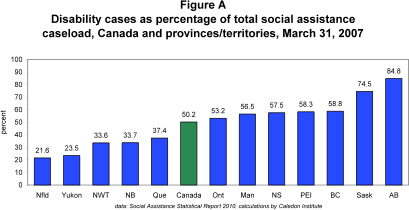
Welfare serves the income substitution function of our social security system. It is the 'last-resort' program for Canadians—so many of them with disabilities—who have little or no income from other sources such as employment and income programs that are based on labour force participation (i.e., the Canada and Quebec Pension Plans and Employment Insurance). Our analysis of the PALS confirmed that Canadians with severe/very severe disabilities have, at most, a tenuous or episodic attachment to the paid labour force. Those who work typically earn low or modest wages in unemployment-prone jobs, and so may have nowhere else to turn but welfare for support.
Delivered by 13 governments—the ten provinces and three territories—welfare varies from one jurisdiction to another in terms of eligibility for assistance, the amount of basic assistance, types and amounts of special assistance, enforcement policies and provisions governing the appeal process. In addition, on most reserves welfare is delivered by First Nations but with an agreement to abide by provincial or territorial regulations. With the demise of federal cost-sharing under the Canada Assistance Plan, abolished in 1995, welfare programs no longer are required to meet any national objectives, standards or requirements (except not to discriminate against applicants who have immigrated from other provinces). Because of the many different laws, it is difficult to generalize about welfare in Canada: Usually there is at least one province or territory that is the exception to almost anything. Nonetheless, all welfare systems share the same basic structure—and the same major strengths and shortcomings.
The core of all provincial/territorial welfare systems is the 'needs test.' A detailed and intrusive investigation into claimants' needs and circumstances, the needs test is used to determine eligibility for and type and amount of benefits from welfare. Applicants' requirements for basic living are identified and costed, often including a nominal budgetary allocation for food, clothing, utilities, household and personal needs. In most provinces, the budgetary allocation for shelter is more than nominal in that welfare pays actual costs or a percent of actual costs up to a maximum, which also requires the submission of rental receipts or the equivalent. Also considered may be special needs such as medication, health-related diets or equipment for a disabling condition.
Next, an assessment is made of applicants' resources—their income from employment and other income programs, savings, support payments, insurance claims, pensions and income derived from any other source—available to meet their needs. In all provinces, various specific types of resources may be fully or partially exempt; for example, compensation paid to thalidomide victims. Then the difference between their non-exempt resources and basic needs is calculated. If there is a 'budget deficit' (i.e., their needs exceed their available resources), then they may be eligible for welfare. Rates of assistance take into account a variety of recipient characteristics such as age, size and type of family (i.e., single, single parent, two parent and childless couple), head's employability, housing requirements and other factors, such as the presence of a disabling condition.
The needs test also includes a stringent accounting of applicants' fixed and liquid assets. Allowable fixed assets are usually limited to applicants' home, a car (up to a specific value), clothing, appliance, furniture and certain types of farm equipment and tools. Liquid assets include cash and cash-convertible bonds, stocks and other securities, although various specific types of financial assets may be exempted in some provinces or territories, such as registered education plans and residential school settlements. The value of non-exempt fixed and liquid assets cannot exceed low limits that also vary from one jurisdiction to another.
In addition to the financial requirements, provinces and territories also have participation requirements of various kinds for most applicants, including actively searching for a job or taking educational up-grading. In most provinces, applicants who are accepted as being on welfare due to a disability are exempt from the participation requirements.
Most provinces and territories have some form of welfare for persons with disabilities. Disabilities must be severe and prolonged, and recipients must be deemed to be unemployable. The extent to which these provincial/territorial 'welfare-like' disability programs are actually different from welfare varies enormously among the provinces and territories. In most jurisdictions, the welfare program for persons with disabilities is almost identical to the main welfare program, except with a little higher benefit. In some provinces, the welfare program for persons with disabilities is more distinct. In Ontario, for example, the program has its own name (Ontario Disability Supports Program), administration and much higher benefits, but in most other respects is the same as mainstream welfare.
Alberta has the disability program that is most unlike welfare. The province's Assured Income for the Severely Handicapped (AISH) program is for recipients with a severe and permanent disability that substantially limits their ability to earn a living [Alberta 2007]. Unlike welfare, Alberta's program does not impose a needs test; it only sets a limit on applicants' (and their spouses') income from other sources (e.g., work, other income programs) and assets.
Welfare offers another very important benefit to recipients with disabilities—access to disability supports required to function in daily life. However, many welfare recipients with disabilities bump up against the 'welfare wall.'[5] Welfare links them to crucial disability supports, but if they manage to move from welfare to the workforce, they may lose access to these vital supports which they often cannot find and afford on their own outside welfare. So once on welfare, many recipients with serious disabilities find it difficult, if not impossible, to leave because that is the only way they can obtain the essential supports they require. Welfare also provides access to other important services (such as supplementary heath care, prescription drugs, dental and vision care, and child care) that generally are not available to the working poor.
In sum, welfare—aptly characterized as 'the tangled safety net' in the classic 1987 report by the National Council of Welfare—is a complicated, rule-burdened system that is hard to understand and often punitive and inconsistent in its treatment of recipients [National Council of Welfare 1987; Caledon Institute of Social Policy 2006].
Welfare in and of itself can present a confusing maze to its clients, obscuring their rights and responsibilities. Welfare recipients are at the mercy of an often harried and under-resourced bureaucracy, required to follow and enforce massive volumes of rules. Welfare workers waste time on policing and paperwork instead of helping clients. Moreover, the welfare appeal system in many provinces is flawed. The rules are so complex that virtually any recipient's files will contain a number of 'errors' and people on welfare live in perpetual fear of sudden and seemingly arbitrary decisions affecting their very capacity to feed their families.
Welfare rates are not indexed, except in Quebec and Newfoundland, leading to long-term decline in real value (and resulting savings to government). Occasional ad hoc increases are rarely sufficient to reverse the stealthy long-term erosion of benefits that fail to keep pace with inflation, as they lose value by the inflation rate each year. For example, if inflation runs at 2 percent a year (the current rate), over just five years welfare benefits lose 10 percent of their value. Welfare is a highly stigmatizing program in the eyes not only of the general public but many recipients themselves. Operating the intrusive needs test and applying various other rules result in a system with relatively high administrative costs.
Welfare rates are higher for recipients with disabilities than for those without, but are all meagre nonetheless. The most recent estimates, for 2008,[6] show that welfare payments to single recipients with disabilities range widely, from just $8,254 in New Brunswick to $20,544 in the Northwest Territories [National Council of Welfare 2010]. Figure B compares the amounts across Canada.
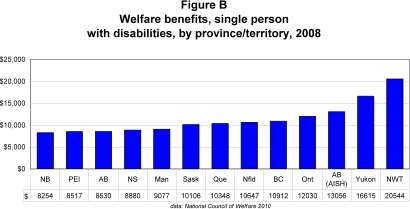
A word of explanation is required about the results for Alberta. Alberta ranks third-lowest in terms of benefits for single persons with disabilities from the province's basic needs-tested welfare program, Alberta Works. However, many single recipients with severe and permanent disabilities move onto the income-tested Alberta Assured Income for the Severely Handicapped (AISH) program. AISH paid $13,056 in 2008—considerably better than the $8,530 from basic welfare for persons with disabilities. Figure B shows incomes from both programs.
It is extraordinary how differently welfare systems across Canada pay their recipients. Differences in living costs—especially in the territories—to some extent may account for these variations, but surely not the full difference. For example, Ontario paid single recipients with disabilities $12,030 in 2008—$1,682 more than Quebec's $10,348. Single welfare recipients with disabilities in Newfoundland got $10,647—$2,393 more than their counterparts in New Brunswick, who received just $8,254.
Benefits are at a level that ensures all recipients have low incomes, though again the results vary a lot from one jurisdiction to another. Measured as a percentage of Statistics Canada's after-tax low income cutoffs for the largest city in each province, 2008 welfare incomes—social assistance benefits as well as federal and provincial/territorial tax credits—for a single person with disabilities ranged from 47.7 percent in Alberta (for its basic welfare program) to 72.8 percent in Alberta (for its AISH program). Figure C illustrates the results. (Results are not available for Yukon, the Northwest Territories and Nunavut because the income survey on which the low income cut-offs are based does not cover the territories.)
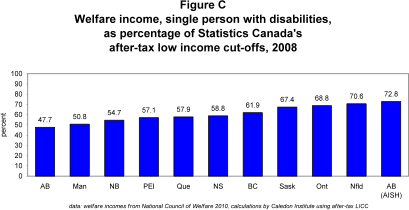
There are significant differences as well in the trend of welfare benefits over time from one province and territory to another. The majority of jurisdictions (9 of 12)[7] show a long-term decline in total welfare incomes (i.e., income from welfare, the federal GST credit and provincial/territorial refundable tax credits) for single persons with disabilities, though some fell further than others. These nine jurisdictions are Newfoundland, Prince Edward Island, Nova Scotia, New Brunswick, Ontario, Manitoba, Saskatchewan, Alberta and British Columbia. The period for which estimates are available is 1989 to 2008.
By contrast, welfare incomes for single recipients with disabilities were higher in 2008 than 1989 in Quebec, Yukon and the Northwest Territories. In Quebec, welfare incomes for single persons with disabilities have been more or less flat since 1991, thanks to indexation that protects benefits from increases in the cost of living. In other provinces, long-term decreases in the value of welfare benefits stems largely from non-indexation; benefits are either frozen—in which case their loss in value each year is equal to the rate of inflation—or occasionally increased on an ad hoc basis but not enough or often enough to keep pace with the cost of living.
The Appendix discusses and illustrates the trend in welfare incomes for single recipients with disabilities in the provinces and territories.
Overall we see that welfare—the program of last resort for Canadians with serious disabilities—remains an inadequate response to their need for income security. The welfare system overall is intrinsically flawed. As long as so many persons with disabilities have no recourse but welfare—through no fault of their own—we will be condemning them to a life of poverty.
Disability Tax Credit
In 1986, the tax deduction for blind persons and those confined to a wheelchair was replaced by the disability tax deduction, a broader benefit for individuals with a serious mental or physical disability. In 1988, as part of income tax reform, the disability deduction (like most deductions and exemptions) was converted to a non-refundable tax credit—the Disability Tax Credit.
The Disability Tax Credit provides income tax relief to help cushion costs for Canadians who, due to severe and prolonged impairments in physical or mental functions, are markedly restricted in their ability to perform at least one basic activity of living (as certified by a qualified health practitioner) or would be markedly restricted were it not for extensive therapy (averaging at least 14 hours a week) to sustain a vital function. Recipients are deemed to be markedly restricted if all or substantially all of the time, even with therapy or the use of appropriate devices and medication, they are blind or unable to perform a basic activity of daily living or require an inordinate amount of time to do so. Such basic activities include walking, feeding or dressing oneself; mental functions necessary for everyday life (such as memory; problem-solving, goal-setting and judgment; and adaptive reasoning); speaking; hearing; and eliminating bodily waste.
In accordance with one of the recommendations of the Report of the Technical Advisory Committee on Tax Measures for Persons with Disabilities [Department of Finance 2004], the 2005 federal Budget [Department of Finance Canada 2005a] extended eligibility for the Disability Tax Credit to individuals with severe and prolonged impairments in mental or physical functions who have significant restrictions in more than one basic activity of living if the cumulative effect of their restrictions is equivalent to having a single marked restriction in one basic activity of living. Take the example of a person with multiple sclerosis who continuously suffers fatigue, depressed mood and balance problems—but each of these restrictions on its own does not markedly restrict a specific basic activity of daily living. Previously, that individual would not qualify for the Disability Tax Credit. Now, however, that person would qualify if the cumulative effect of the restrictions is equivalent to having a single marked restriction in one basic activity of daily living.
The Disability Tax Credit is intended to help reduce the financial burden of non-discretionary disability-related expenses that are hard to quantify. Such hidden and indirect costs of disability include, for example, higher utility costs for heat or air conditioning, additional transportation costs and higher prices for goods because of fewer shopping choices [Torjman 2002].
In the 2009 taxation year, the 'face amount' of the Disability Tax Credit (i.e., the amount listed on the income tax form) was $7,196. However, this is misleading because the Disability Tax Credit is not actually worth $7,196. Rather, its true value is calculated as the face amount times the tax rate on the lowest income tax bracket. In 2009, the lowest tax rate was 15 percent, so the maximum value of the Disability Tax Credit in federal income tax savings was $1,079 (15 percent of $7,196). The cost to the federal treasury of the Disability Tax Credit was an estimated $415 million [Department of Finance Canada 2009]. In 2008, the most recent year for which data are available, 889,600 Canadians qualified for the Disability Tax Credit and caregiver credit [Revenue Canada 2010]. The federal Disability Tax Credit is indexed each year to the cost of living.
Taxpayers who qualify for the federal Disability Tax Credit also enjoy a reduction in their provincial or territorial income tax, the value varying from one jurisdiction to another depending on the 'amount' and associated tax rate (ranging from $356 in British Columbia to $1,294 in Alberta in 2009). Thus the disability tax credit paid a total federal-provincial/territorial maximum benefit in 2009 that ranged from $1,435 in British Columbia to $2,373 in Alberta, as illustrated in Figure D. Most, but not all, provincial and territorial disability tax credits are adjusted annually to take into account the increase in the cost of living; Prince Edward Island and Manitoba did not increase their disability tax credits in 2009. (Estimates of the cost of the provincial and territorial disability tax credits, and the other tax credits discussed below, are not available.)
The Disability Tax Credit is 'nonrefundable': It reduces income tax owing but does not pay anything to recipients with incomes so low that they do not owe income tax. However, the Disability Tax Credit can be transferred to a supporting spouse or relative. Thus a low-income recipient of the disability tax credit who does not pay income tax still may benefit indirectly by transferring the tax savings to a supporting spouse or relative who owes income tax and thus gets a tax break from the disability tax credit. In addition, some Disability Tax Credit recipients with low income receive a partial Disability Tax Credit because their income tax owing is less than the maximum Disability Tax Credit benefit. For example, if their federal income tax is $500, then their maximum value of the Disability Tax Credit is $500.
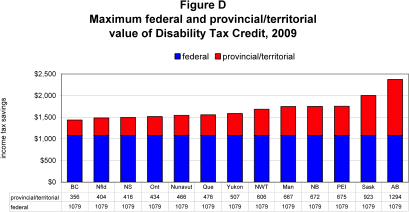
As noted, a taxfiler eligible for the Disability Tax Credit must have taxable income before it is possible to enjoy the full value of the disability tax credit. However, the amount of taxable income needed to do so varies among provinces and territories because they have different basic personal credits (resulting from different basic personal amounts and lowest tax rates). Using Alberta as an example, and assuming only the basic personal credit and no other credits except the Disability Tax Credit, a Disability Tax Credit-eligible claimant needed a minimum taxable income of $15,330 in 2009 to benefit fully from the Disability Tax Credit. Most taxpayers have additional tax credits and deductions, so the threshold taxable income needed to obtain full value of the Disability Tax Credit is consequently higher than $15,330.
If an eligible recipient does not have sufficient taxable income to benefit fully from the Disability Tax Credit, the claim can be transferred to a supporting spouse, parent or family caregiver, so some additional familial benefits may sometimes be obtained in this manner, even for claimants who do not owe sufficient tax themselves. This is useful only if there is an available transferee and that person has sufficient taxable income to realize a tax savings from the Disability Tax Credit.
The Report of the Technical Advisory Committee on Tax Measures for Persons with Disabilities discussed the purpose and design of the Disability Tax Credit. According to the Report, the federal Department of Finance sees the purpose of the Disability Tax Credit as promoting 'horizontal equity' [Technical Advisory Committee on Tax Measures for Persons with Disabilities 2004]. In the tax system, 'horizontal equity' is usually considered to mean that taxpayers of similar ability to pay should pay similar amounts of tax. The Disability Tax Credit allows a rough average of non-itemizable disability costs to be taken into account when computing income taxes owed, so that a taxpayer with a disability ends up paying about the same tax on his or her 'after disability costs' disposable income as does a taxpayer without a disability, assuming no other non-deductible disability-related expenses.
From our perspective, the Finance Department view reflects only one aspect of 'horizontal equity'—as it is confined to the income tax system and those who pay income tax. A broader social conception of horizontal equity argues that the added cost of disability should be recognized for everyone with a disability, so that their 'after disability costs' are at least roughly compensated for the additional non-itemizable expenses related to disability, whether or not they pay any income tax. In this social conception, horizontal equity requires that everyone with a disability—not just those with taxable income above a certain amount—should benefit from the Disability Tax Credit. This disability tax break should be related to the fact of having a disability, and not to the person's income.
The existing Disability Tax Credit does not appear to reach most Canadians with severe disabilities. In the 2007 tax year, there were 442,240 recipients of the Disability Tax Credit who obtained the full value of the Credit by virtue of having sufficient taxable income. In addition, another 223,320 (or more) persons claimed the Credit but obtained less than the full value or no value at all, by virtue of having insufficient taxable income (for some of these it could be that maintaining Disability Tax Credit certification is a condition of access to other programs). If we make the rough assumption that 60 percent of filers are of working age, which is roughly the PALS percent for those with serious and severe disabilities, then about 265,000 working age people got the full value of the Disability Tax Credit in 2007 and another 130,000 might have gotten some value [Data from Canada Revenue Agency web site http://www.cra-arc.gc.ca/gncy/stts/gb07/pst/fnl/html/tbl10-eng.html Final Basic Table 10: Selected items by total income class, All Canada and correspondence].
However some 977,080 adults under 65 reported severe or very severe disabilities in 2006. So Disability Tax Credit recipients represented only around 30 to 40 percent of the potential target group at last count. Moreover, the persons with disabilities that the Disability Tax Credit is failing to reach are exactly those who have the least income. This significant shortfall shows the extent to which the Disability Tax Credit in its present design is ineffective in assisting all persons with severe disabilities. The redesign of the Disability Tax Credit as a refundable credit is discussed in the second part of this report. In other programs such as the Canada Child Tax Benefit and GST refundable credits have proved capable of reaching almost 100 percent of eligible recipients.
Enabling daily living: supports for Canadians with disabilities
The disability community has long argued that access to disability supports must be improved to promote participation—not only in the labour market but also in training and education, culture, recreation and the political life of the community. Disability supports are a range of goods and services that help mitigate the effects of a disabling condition. These can be classified into three streams: [Torjman 2000].
- Technical aids and equipment include wheelchairs, visual aids, volume control devices, prosthetic appliances, work-related equipment such as scanners, TTDs (teletypewriter devices) and large computer monitors. There also are health-related goods such as special dressings, oxygen equipment, dialysis equipment and surgical dressings.
- Personal services are made up of attendant services that help with personal needs such as feeding, bathing and dressing; homemakers services to assist with household tasks such as meal preparation and home maintenance; home health care such as help with dialysis; respite for families caring for children with severe disabilities and aging parents; and interpreter, reading and other communications services.
- Brokerage supports include information and counselling services required to identify, organize and manage disability supports.
The majority of Canadians with disabilities need some form of disability support. However, many who require assistance to live independently or who want to participate in education, training or the labour market are unable to do so fully because they have limited or no access to disability supports. The dearth of disability supports affects not only many working age adults and seniors, but also children with disabilities and their families.
There are problems regarding the availability, cost and responsiveness of disability supports. There is no system to speak of, but rather a hodgepodge of public and private arrangements. Provinces and territories (municipalities in some jurisdictions) are responsible for the provision of these supports. In many cases, non-profit organizations actually deliver the services—when these happen to be available. The supports that may be provided in one jurisdiction may not exist elsewhere. The services to which individuals have access are a function of where they live, the social programs for which they are eligible and whether they can afford to buy services. Cost and lack of insurance are the most frequent obstacles reported by Canadians looking for disability supports, but sometimes there is simply no delivery system or provider even if cost is not at issue. Problems of availability are particularly acute in rural and northern regions of the country [Torjman 2000: 7-8].
A majority of the adult population with disabilities—63.1 percent or 2,658,250 out of the total 4,215,530 in 2006—needs assistive devices or aids [Statistics Canada 2008]. Need for assistive devices or aids varies widely according to the severity of disabilities, from 90.0 percent for adults with very severe disabilities to 80.4 percent for those with severe disabilities, 64.4 percent of those with moderate disabilities and 39.0 percent of those with mild disabilities.
While two-thirds (61.3 percent or 1,628,160) of all adults with disabilities who require assistive aids or devices have their needs fully met, 28.9 percent (767,290) have some of their needs met and the remaining 9.9 percent (262,800) have their needs unmet.
Severity of disabilities is a strong factor regarding the two categories of all needs met and some needs met. The proportion of adults with disabilities whose needs were fully met was 41.3 percent for those with very severe disabilities, 57.6 percent for those with severe disabilities, 68.5 percent of those with moderate disabilities and 75.9 percent of those with mild disabilities. The proportion of adults with disabilities whose needs were partly met ranged from 51.9 percent of those with very severe disabilities to 32.9 percent for those with severe disabilities, 19.9 percent of those with moderate disabilities and 12.9 percent of those with mild disabilities. However, there is no consistent pattern for those with no needs met—6.9 percent for adults with very severe disabilities, 9.5 percent of those with severe disabilities, 11.6 percent of those with moderate disabilities and 11.2 percent of those with mild disabilities.
Cost is a serious impediment. More than half (56.1 percent) of those with unmet need in assistive devices or aids identified cost as a barrier.
Part B: A Basic Income Plan for Canadians with Severe Disabilities
More than 200,000 Canadians with severe or very severe disabilities must rely upon provincial/territorial welfare or upon welfare-like programs for their income and disability supports. As discussed in the previous section, the amounts paid are generally inadequate, leaving many recipients in deep poverty. Even in the few jurisdictions where benefits are better, the whole archaic apparatus of welfare remains—with its including limitations on assets, frequent reviews of income, personal investigations and the eternal stigma of 'welfare.'
The three disability measures critiqued above—welfare, the Disability Tax Credit and disability supports—can be transformed into a new Basic Income Plan for Canadians with severe disabilities, consisting of three reformed components:
- a new federal Basic Income program that would replace provincial/territorial welfare for working age persons with severe disabilities
- a refundable Disability Tax Credit that would extend the Disability Tax Credit to the poorest Canadians with disabilities
- reinvestment of resulting provincial/territorial windfalls to fund a coherent and comprehensive system of disability supports for all persons with disabilities
Together, these three interrelated reforms would represent a huge change in Canada's programs for persons with severe disabilities. In the following pages, we set out an illustrative and detailed design for the changes required to construct our proposed Basic Income program. In proposing a series of design parameters our goal is not so much to insist on any particular amounts, but rather to illustrate with some detail and precision how these three reforms could be implemented. Our main point is to demonstrate that the missing ingredient is not policy or administrative capacity—or even cost as there have been any number of tax and spending initiatives in the last decade and planned for the next decade that cost much more—but rather political will.
Reform 1: A new Basic Income program for Canadians with severe disabilities
Our proposed Basic Income program for people with severe disabilities would mark a major shift in Canadian social policy. It would replace long-existing welfare benefits delivered by provinces and territories with a new federal program serving all Canadians with severe disabilities, no matter where they live. But the Basic Income proposal is not a brand new idea requiring a leap of faith. Far from it, the Basic Income program would be a close model of the long-established and well-regarded Guaranteed Income Supplement for low-income seniors.
Eligibility
The nonrefundable Disability Tax Credit that we discussed earlier and the proposed refundable Disability Tax Credit that we will put forward later are not income security measures, but rather 'equity' programs meant to compensate at least roughly for the added non-itemizable and non-reimbursable costs of disability. This is why the Disability Tax Credit has a relatively low benefit level: It is not an amount on which people are meant to live.
The Basic Income, on the other hand, is an income security program. Its benefits must be sufficient for recipients to pay their rent, buy their food, participate in society and, generally, enough on which to live. But a program with higher benefits will not be supported politically unless the public is convinced that it is fair and represents a justified use of taxes. Canadians will not accept a program that provides adequate benefits with few strings attached but goes to people who have other sources of income or are capable of earning their own income from employment. In addition, politicians have seen caseloads on disability-related programs in some countries escalating, so would be leery of any Canadian program that did not provide for rigorous eligibility criteria.
Most people with disabilities are just as capable of earning a living from employment as anyone else, especially if barriers are minimized or removed. Thus a program that entitled every person with a disability to a form of adequate and guaranteed income, just because of the presence of a disability, would include many people who are quite capable of earning their own income like anyone else. It is our belief that the Canadian public will not support a program paying reasonable benefits to people who can earn their own living, even if that person happens to have a disability. Social measures must be sustainable politically as well as financially, so the real choice in designing a new Basic Income program is between weak eligibility and adequate benefits: We cannot have both.
In our design, we accept the need for rigorous eligibility standards to provide public support for a decent benefit system. In other words, there will have to be a high fence around the Basic Income program in respect of determining eligibility. Once a person is over the fence, there will be relatively generous treatment and many fewer rules. Inevitably some people will find themselves on the wrong side of the fence, but these should be no one worse off than today, while most Canadians with severe disabilities would be much better off under our proposal.
In respect of the test of eligibility, we have a vision for the longer term, and a proposed practical approach for the shorter term. Over the long term, the Basic Income program should become a mainstream measure not just for people with severe disabilities, but available to anyone who cannot reasonably be expected to earn an adequate income from employment. However, this vision would require a novel approach to testing eligibility. We anticipate that the federal government would be reluctant to adopt a new approach to eligibility for the Basic Income program without a good deal of experience with the program itself.
Therefore we propose, as a first step, introducing the new Basic Income program using a variation of tests with which the federal government is already experienced and reasonably comfortable, so that it does not feel potentially overwhelmed by administrative complexity and an unanticipated flood of applicants. For the near term, we suggest that the Basic Income program use the Disability Tax Credit's eligibility test for 'disability' and a clarified version of the existing Canada/Quebec Pension Plan Disability (C/QPPD) test for 'the capacity to earn an adequate income from employment.'
The federal government is already administering both the Disability Tax Credit disability test and the C/QPPD 'employability' test, and has deep experience in all aspects of its administration. There should be no practical impediment to using the same apparatus to test applicants who do not necessarily have a contributory record, as well as those who do. Panels, appeals and all the administration already exist and would only need to be scaled up. Ottawa should feel confident with its expertise. As a side benefit, anyone who establishes eligibility for C/QPP Disability should also be automatically eligible for the Disability Tax Credit and so should, in turn, automatically be eligible for the new Basic Income (but not vice versa). This change would permit benefits to be readily maximized for C/QPPD recipients.
Many in the disability community have not had a good experience with the C/QPPD 'employment' test. Nevertheless, in this case the advantages outweigh the disadvantages, especially if this is seen as an incremental step towards a better eligibility test and if some changes are made to the test for the purposes of determining Basic Income eligibility.
An adaptation of the C/QPPD eligibility test is needed for Basic Income to recognize the partial employability of many Basic Income recipients, as well as harmonizing with some aspects of the proposed refundable Disability Tax Credit test. Currently, eligibility for Canada Pension Plan Disability is defined as follows [subsection 42(2) of the Canada Pension Plan Act]:
"a person shall be considered to be disabled only if he is determined in prescribed manner to have a severe and prolonged mental or physical disability, and for the purposes of this paragraph
(i) a disability is severe only if by reason thereof the person in respect of whom the determination is made is incapable regularly of pursuing any substantially gainful occupation, and
(ii) a disability is prolonged only if it is determined in prescribed manner that the disability is likely to be long continued and of indefinite duration or is likely to result in death."
In essence the C/QPPD eligibility test is a two-part test. Part one consists of a definition of prolonged disability. Part two consists of the relationship of provincial/ territorial disability to "pursuing any substantially gainful occupation."
The precise wording and structure of an eligibility test for Basic Income will require much discussion. As previously noted, we suggest a two-part eligibility test combining the Disability Tax Credit disability test with a test of the applicant's relationship to the labour market, adapted from the C/QPPD. Part one of the new test would ask: does the applicant have a 'disability' as defined by the Disability Tax Credit? However, we recognize that the Basic Income test must also include an assessment of the applicant's relationship to the labour market. So the second part of the Basic Income eligibility test would ask: Does the applicant have incapacity to earn an adequate income due to disability? The applicant would have to pass both parts in order to be eligible for Basic Income.
With respect to part one, there is no reason for the definition of disability for Basic Income to be more onerous than that in the Disability Tax Credit, so we would urge the adoption of the Disability Tax Credit definition of disability for Basic Income. This would include the definition of "prolonged" as at least 12 continuous months, rather than the more onerous "long continued and of indefinite duration or is likely to result in death" in the current C/QPPD test.
With respect to part two of the test for eligibility for Basic Income, the current C/QPPD requirement—is the disability such that is causes the applicant to be "incapable regularly of pursuing any substantially gainful occupation?"—seems too broad and all-encompassing, and might be interpreted as effectively preventing almost any meaningful employment. We would instead suggest that an applicant shall be entitled to Basic Income "only if by reason of a disability (as defined in part one of the Basic Income test) the applicant cannot reasonably be expected to obtain an adequate income solely from employment." This would introduce a broader standard, allowing individuals to work while retaining eligibility for Basic Income, and also include the need to assess the real state of the labour market. This is more or less the interpretation of the C/QPPD test in the Villani case by the Federal Court of Appeal, but this broader interpretation is clarified by the suggested Basic Income test.
Basic Income parameter
The parameters of the Basic Income program are proposed as follows:
| Basic Income Variables | Annual Values | Notes |
|---|---|---|
| Income-tested maximum Basic Income benefit for a single person | $12,160 | $12,160 + $2,000 (refundable Disability Tax Credit) = $14,160, the maximum Old Age Security/Guaranteed Income Supplement (OAS/GIS) benefit as of October 2010 |
| Percent of two single benefits to which an eligible couple is entitled | 81% | 81% is the percentage of two single maximum OAS/GIS benefits paid to a couple both of whom are 65+ |
| Allowance for each dependent under 18 | $2,578 | $214.85 per month is the maximum dependent allowance in CPP/D as of October 2010 |
| Reduction rate on Basic Income as income from other sources increases | 50% | 50% is the reduction rate in the GIS |
| Exempt income | $1,200 | Income disregard before reduction rate is applied |
| Northern and Remote allowance (per household member) | $1,680 | $140 per month is the Northern Allowance for a single person in the Ontario Disability Support Program |
Figures E through J illustrate the configuration of benefits for a single adult, one-parent and two-parent families with one and two children and childless couples. These graphs include all the variables in the above table, excluding the Northern and Remote allowance.
In the following we review each of these components in turn. In the next section, we explain the conversion of the Disability Tax Credit into a refundable credit which we assume in this section.
Maximum Basic Income benefit
We are proposing that, at least initially, the Basic Income benefit be promoted as an extension to persons with severe disabilities of the income guarantee now provided for low-income seniors over 65, so it would be set at the maximum Old Age Security plus Guaranteed Income Supplement (OAS/GIS) for a person over 65 with no other income, less the refundable Disability Tax Credit (discussed later). As with other government income-tested programs, this income would not be taxed.
The OAS/GIS benefit level for low-income seniors has already been socially accepted, so it should be relatively non-controversial to advocate for this amount. Moreover, the OAS/GIS has proven successful in helping to greatly reduce poverty among seniors—certainly eliminating the deepest poverty. In theory, were there an official poverty line or similar indicator, we might propose using that amount instead. But there is no such official indicator in Canada and it is likely more acceptable to use an existing social benefit rather than a theoretical construct.
Old Age Security requires ten years' residence in Canada to establish full eligibility. We think the Basic Income program should be available to all residents of Canada equally, without a length of residency condition. The Basic Income would be available to any adult of working age with severe disabilities filing a tax return and legally resident in Canada.
Couples
It is proposed that where both adults are eligible, the combined maximum benefit of the Basic Income plus the refundable Disability Tax Credit be set at 81 percent of the single benefit for two people, to reflect the same adjustment as is made in the OAS/GIS. This adjustment is to compensate for the more economical living arrangements of couples. Both adults would be counted as eligible if both meet the Basic Income eligibility criteria or if one meets the criteria and the other is a substantially full-time caregiver. If both adults are not eligible and assistance is still required for the non-eligible adult partner, then that partner would have recourse to provincial/territorial social assistance. It is also proposed to test for family rather than individual income using the same definition—net family income—as in other income-tested programs such as the Canada Child Tax Credit and GST credit.
Dependent allowance
In addition to the Canada Child Tax Benefit, guardians of dependent children under 18 years of age would be entitled to a dependent allowance, reflecting the current dependent allowance in the Canada Pension Plan. The dependent allowance would be added to the core benefit, so that it would decrease only after the core Basic Income benefit was reduced to zero—in other words, at net incomes above about $27,000 for a lone parent, or above $42,000 for a couple both of whom are eligible. The total dependent allowance plus Canada Child Tax Benefit would be more than $6,014, which is a little higher than the $5,000 minimum adequacy level advocated by most social groups. In addition, families with children under age 6 receive the Universal Child Care Benefit of $1,200 a year per eligible child. Families whose child has a disability are also entitled to the income-tested Child Disability Benefit of a maximum $2,300 per year.
The reduction rate as income increases
Basic Income is an income-tested program, which means that it decreases as income increases. There would be no restrictions on recipients of Basic Income working or earning income. Instead the program would work like the Guaranteed Income Supplement (GIS): As income goes up, the Basic Income benefit would be reduced by 50 percent of other income.
Although 50 percent is a high taxback rate, it is the amount currently used in the GIS so can be considered socially acceptable. The reduction rate also determines the level of income at which a recipient continues to receive a benefit. With a high benefit level as proposed for the Basic Income, a lower reduction rate would imply that individuals with above-average levels of income would continue to receive some Basic Income. For example, the suggested Basic Income guarantee is $25,948 for a lone parent with two children. A reduction rate of 50 percent means that some Basic Income continues until income is more than $50,000. If the reduction rate were 25 percent, some Basic Income would be paid until income reaches more than $100,000.
On the other hand, some forms of income would offset Basic Income benefits by 100 percent, as the Basic Income is designed as a last resort program. Basic Income recipients would not get 50 percent of CPP or QPP disability benefits added onto their Basic Income benefits: These would be fully offset. Similarly, all other disability benefits—such as Workers' Compensation and private disability benefits—would fully offset Basic Income. Because Basic Income is the 'last payer,' a dollar of disability benefits from any other source results in a dollar reduction of entitlement to Basic Income. Otherwise, Basic Income would be in the peculiar position of 'double counting' disability benefits.
One specific problem is that Canada and Quebec Disability benefits are subject to income tax, as are some private disability benefits, so that a 100 percent offset of non-taxable Basic Income can actually make a recipient worse off. This problem (which also exists in current programs today) can be resolved by taking into account the after-tax value of benefits, rather than the before tax value, although the precise mechanisms for doing so would need to be worked out.
One issue that may be of concern is that of 'dumping' from other programs onto Basic Income (i.e., provinces and territories attempting to minimize the numbers on their programs and maximize the number of recipients on Basic Income). This should not be a problem for the CPP since the federal government would be interested in minimizing the use of a program funded from general revenue (Basic Income). With respect to other programs, this question would require on-going monitoring, but it is not an insurmountable problem as it is common today in many insurance situations and simply requires diligence. In the end, however, all those who are entitled to be on Basic Income should be enrolled and there should not be a problem with the provinces and territories encouraging applicants.
Exempt income
It is proposed to exempt the first $100 a month of income, other than the income from other programs that automatically is counted at 100 percent (which is called subrogated income). This annual exemption of $1,200 reflects additional costs entailed for working, as well as providing more incentive for part-time work. It would also be possible to exempt some of the income from a registered trust or similar instrument established on behalf of a person with disabilities. Note that if the program is administered through the income tax system (discussed below), income that is not reported on income tax would automatically be exempted unless special rules were imposed to take it into account. Consequently, some important sources of income for persons with disabilities that are currently contentious in welfare rules would be fully exempted, including most gifts, inheritances, life insurance, capital gains from the sale of a principal residence and child support payments.
Northern and Remote Allowance
One of the issues that must be considered in any cross-Canada program is the question of differing cost-of-living and average incomes in various regions. We propose that, as a national program, Basic Income should pay the same rate of benefits everywhere in Canada, as is the case for the OAS/GIS, the Canada Child Tax Benefit and other non-contributory programs funded from general tax revenue. To recognize regional differences, provinces would be able to top-up Basic Income benefits, using the federal administrative machinery, as is done for the Canada Child Tax Benefit. Provinces would also be able to top up the refundable Disability Tax Credit.
The one exception to the 'single payment across Canada' would be the North, where most of the residents are a federal responsibility in any case (either by virtue of being in a territory or living on a reserve). In the case of the North, where higher living costs are well known, it is appropriate for the federal government to take responsibility for regional top-ups. For this reason, we have included a Northern and Remote allowance. The details of exactly where the allowance would apply would have to be worked out. It is assumed that it would apply at least to all remote reserves and the territories.
Delivery mechanism and responsiveness to change in circumstances
The easiest and least stigmatizing way to deliver the Basic Income is through the tax system, wherein the amount of Basic Income would be calculated according to the income reported in the most recent tax form. This should be possible to do because most Basic Income recipients will have reasonably stable incomes—much like the elderly. Basic Income, delivered through the tax system, would not be at all like the present welfare-type programs that so many people with disabilities have to use. There would be no reports required on shelter costs or utility costs, no monthly reporting and no income maintenance worker. The only financial reporting required in normal circumstances would be an income tax form (or permission for the federal government to access one's tax return).
The difficulty with this delivery mechanism is that income as reported in the income tax form can be many months out of date. This would not be a problem for recipients with reasonably stable income, but what happens if a recipient's income fluctuates during the year? For example, imagine a recipient worked in 2008, earning $11,200 (ignoring smaller adjustments for simplicity). Basic Income would be reduced by $5,000 in 2009, after income tax for the 2008 tax year has been filed and processed. But imagine that the person is no longer working in 2009. Does she have to do without $5,000 for all of 2009 and wait until 2010 before the Basic Income system adjusts benefits to the new reality?
It is proposed that the Basic Income allow for in-year enrolment and changes in income at the discretion of the client, so long as those changes are more than a minimal amount (say, equal to at least 10 percent of benefits). Recipients would not be required to report increases in income immediately, but would be able to obtain a rapid increase in their benefits if their income declined, or if there were other changes in circumstances. This special adjustment would continue until the regular adjustment based on the tax year came into pay.
This proposal would provide compensation for decreases in income, but would not obtain any savings for in-year increases in income, so it will add to the cost of the Basic Income program. Both the UK and Australia have implemented much more complex systems for in-year adjustments, but both countries have ended up with a good deal of dissatisfaction and made expensive accommodations in any case—the worst of all possible worlds. The simpler approach suggested here makes more sense. We assume in our estimates of cost that permitting in-year increases, without offsetting in-year decreases, will add approximately 10 percent to total costs.
If this method of in-year adjustment is too expensive, another albeit less satisfactory, option would be to rely on provincial/territorial welfare as the fall-back while waiting for income to be adjusted at the point of tax filing. Obviously this would be much less attractive to recipients, but it would also reduce the cost of the Basic Income package.
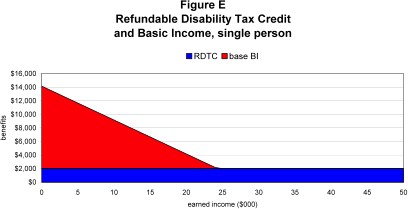
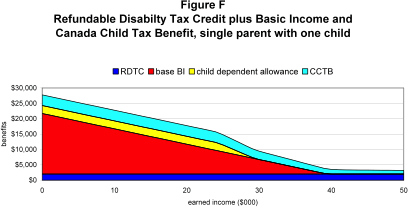
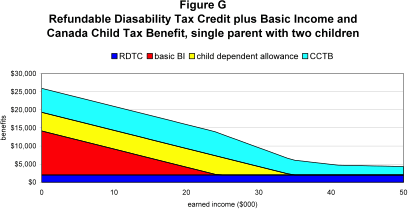
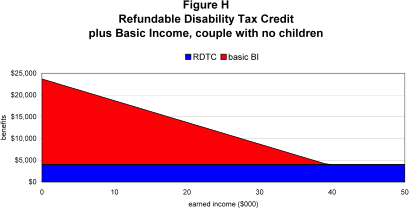
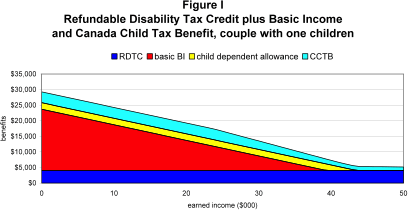
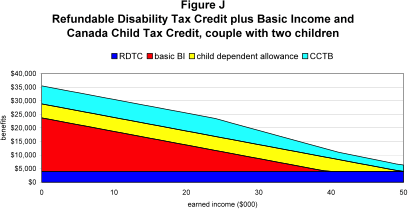
practicable reform
The Basic Income program is not proposed as an 'ultimate' ideal solution for all problems facing Canadians with disabilities. It will not cover everyone with disabilities now on welfare. The traditional provincial/territorial welfare for those with disabilities will have to remain, although it will be a much smaller program. Further, Basic Income does not provide a completely new comprehensive disability income plan as has been envisaged in various reports in Canada and abroad over the years, notably Canada's pioneering Obstacles report of the Special Parliamentary Committee on the Disabled in1981. Where and how a disability is acquired would continue to affect the amount of benefits to which a recipient is entitled. Basic Income also would continue to require a rigorous and demanding test in order to establish eligibility. Any such test unavoidably implies that some with disabilities will not be eligible.
For those whose standard for reform is all-or-nothing, the Basic Income proposal here may not be acceptable. Our view is that an achievable reform that would have a large positive impact should not be rejected because it is does not solve each and every problem. The Basic Income Plan is designed to be a practical 'doable' reform that could be implemented with relative administrative ease at a sustainable cost given today's political institutions, income security technology and culture. Basic Income would not necessarily represent the best-of-all-possible worlds, but it would result in an immense improvement in the well-being of hundreds of thousands of people with disabilities, especially many who are today in deepest poverty. It would be the first major progress in over half a century against the scourge of deep poverty pervasive among persons with disabilities in Canada.
Moreover, the Basic Income program would not stand alone. It is proposed here as one part of the Basic Income Plan, a three-part reform of programs for persons with disabilities: Implementing the Basic Income program would require two equally important collateral structural reforms of programs for person with disabilities—the Disability Tax Credit, to which we now turn, and disability supports, discussed later.
Reform 2: Conversion of the Disability Tax Credit to a refundable credit
As discussed previously in this report, the nonrefundable Disability Tax Credit is currently the main federal program to recognize 'non-itemizable and non-reimbursable' costs of disability, by providing for a reduction in income tax payable for anyone who meets the Disability Tax Credit test of eligibility. An applicant is eligible for the Disability Tax Credit if he or she has a prolonged impairment that markedly restricts basic activities of daily life, or a combination of prolonged impairments which together have a similar effect, or if he or she requires life-sustaining therapy. 'Prolonged' is defined as at least 12 continuous months. Note that the Disability Tax Credit test of eligibility is not related to employability: A lawyer in a wheelchair earning $250,000 passes the Disability Tax Credit test.
Our earlier discussion of the Disability Tax Credit noted several shortcomings of this tax benefit. For one thing, it is something of a stealth program, appearing bigger than it really is. On the income tax form the Disability Tax Credit's 'amount' is given as $7,196 for 2009, but its actual value in income tax savings is calculated as the amount times the lowest tax rate ($7,196 times 15 percent), which works out to $1,079.
The provinces and territories provide their own Disability Tax Credit in widely varying amounts according to their amounts and lowest tax rates. Recipients in British Columbia receive a maximum $356 in provincial tax savings (the $7,030 amount times the 5.06 percent lowest tax rate) that is the lowest benefit in the country. Yet their neighbours in Alberta receive $1,294 ($12,940 times 10 percent) that is the highest benefit of all the provinces and territories.
Because the Disability Tax Credit is nonrefundable, a claimant has to file a tax return and be liable for at least the value of the Disability Tax Credit in tax savings ($1,079 in 2009) in order to obtain the maximum tax reduction. Claimants with incomes greater than zero but less than $7,196 receive smaller credits.
The amount of taxable income needed to get the full provincial/territorial Disability Tax Credit varies among jurisdictions because they have different basic personal credits (resulting from different basic personal amounts and lowest tax rates). Using Alberta as an example, and assuming only the basic personal credit and no other credits except the Disability Tax Credit, a Disability Tax Credit-eligible claimant needed a minimum taxable income of $15,330 in 2009 to benefit fully from the Disability Tax Credit. Most taxpayers have additional tax credits and deductions, so the threshold taxable income needed to obtain full value of the Disability Tax Credit is consequently higher than $15,330. If an eligible recipient does not have sufficient taxable income to benefit fully from the Disability Tax Credit, the claim can be transferred to a supporting spouse, parent or family caregiver, so some additional benefits may be obtained in this manner, even for claimants who do not owe sufficient tax themselves. But this is a benefit only if there is an available transferee and that person in turn has sufficient taxable income.
In view of the many faults in the current Disability Tax Credit, we propose that the nonrefundable Disability Tax Credit be converted to a refundable credit for claimants between the ages of 18 and 65 to compensate partly for the added costs of disability, so that it applies to all Canadian residents of working age with disabilities, regardless of income. (We are not here dealing with persons over 65.) A refundable Disability Tax Credit will provide a universal foundation for the Basic Income and permit the Disability Tax Credit to integrate easily with the new Basic Income system. As a refundable credit, the full amount would be available to all eligible recipients whether or not they pay income tax. Since every recipient would now be eligible in his or her own right, there would no longer be a need to provide for transferability of the Disability Tax Credit, which is an added bonus in promoting independence. And the stealth problem of the true value of the nonrefundable Disability Tax Credit would be fixed: With a refundable credit, what you see is what you get.
An analysis of non-reimbursed costs of disability [Crawford 2005] found that among persons with disabilities who had disability related expenses of at least $1,000, about half had expenses of less than $2,000 and half had expenses greater than $2,000. Therefore, we would suggest that an amount of $2,000 annually might be considered the 'adequacy level' for non-reimbursed disability costs of persons with severe or very severe disabilities, pending more detailed studies.
We propose that the refundable Disability Tax Credit be established as a uniform national program and that the amount be adopted for all of Canada. $2,000 is greater or equal to any current combined federal and provincial/territorial Disability Tax Credit except in Alberta ($2,373) and a very few dollars in Saskatchewan ($2003). Alberta, and other provinces if they wished to do so, would be permitted to 'top up' the new national refundable credit so that benefits are not reduced for anyone as a result of the conversion of the Disability Tax Credit to a refundable format (so that no one is worse off with a refundable Disability Tax Credit).
Everywhere across Canada, in all provinces and territories, including Alberta and Saskatchewan, persons with disabilities eligible for the Disability Tax Credit who have little or no taxable income would be better off by $2,000—the full value of the refundable Disability Tax Credit. This seems to be about 70 percent of those with serious disabilities of working age. In every province but Alberta and Saskatchewan, all current recipients of the Disability Tax Credit would be better off. Current recipients of the maximum benefit would be no worse off in Saskatchewan and Alberta, assuming the latter province chose to continue to top up the federal credit.
The refundable Disability Tax Credit would be a federal program paid by the federal government. This results in increased tax revenue to the provinces and territories, because they no longer would have to provide their own Disability Tax Credits (except in the case of possible top-ups). We are proposing that the federal government proceed with the refundable Disability Tax Credit only with firm agreements in hand with the provinces and territories that their increased revenues would be used for disability supports. We discuss federal-provincial issues later in this paper.
Our expectation is that after a few years almost every person who is eligible for the refundable Disability Tax Credit would claim it, especially if there is an active information campaign to accompany the reform, resulting in a significant improvement in income for almost all low-income persons with disabilities. In addition, most eligible members of First Nations living on reserve would likely file claims and obtain the refundable credit. Special arrangements could be made for non-tax filers on reserves, as has been done for the Canada Child Tax Benefit.
Assuming all those working age adults with severe or very severe disabilities obtained the new refundable credit, the total gross cost of the refundable Disability Tax Credit would be approximately $1.9 billion. Current federal costs for adults, including transferred claims, are at a rough guess $450 million,[8] so the net federal cost would be about $1.45 billion. Additional revenue to the provinces would be in the order of $100 million.
Reform 3: A disability supports program
Assuming about 250,000 current recipients leave provincial welfare at a saving averaging about $10,000 each in cash benefits, our estimate of the savings to the provinces and territories as a result of the introduction of the Basic Income program is about $2.5 billion—a very rough estimate, but probably in the right ballpark. In other words, the provinces and territories would save a huge amount of money due to the introduction of the Basic Income. No one should be surprised by this, as the provinces and territories are now supporting hundreds of thousands of people with disabilities on welfare, and about half of these would instead be entitled to more generous and less intrusive Basic Income program financed and operated by Ottawa.
These funds are more than sufficient to pay for a universal disability supports program in each province. As explained earlier, such a disability supports program has been identified as the highest priority of the disability community. Disability supports are devices, services or assistance that are required due to disability to assist in daily activities in the home, work or community. In addition, we would say that provinces and territories should also be required to provide substantial training, workplace accommodation and employment supports for persons on Basic Income seeking employment or attempting to upgrade their skills in order to obtain employment.
There must be a federal-provincial/territorial agreement on a national disability supports program, which would be delivered by the provinces and territories but with agreed upon minimum national standards [Torjman 2000]. Doubtless the negotiations would be long and tough, but with federal financing available and contingent upon an agreement, it should be possible to come to a resolution.
This paper deals mainly with a new income security program and tax benefit for persons with disabilities, so we do not here explore further the design of a universal disability supports program. We note only that the introduction of a federal Basic Income program provides the key to financing a national disability support program delivered by the provinces and territories, of a size and scope that could make Canada a leading nation in this respect. Other strategies have proven unworkable. The federal government will not agree to simply hand over money to the provinces and territories to deliver their program using taxes raised by Ottawa. Nor will the provinces and territories agree to introduce a national disability supports program without federal financing. Through the Basic Income, we break this Gordian knot and get the best of both worlds: a vastly improved income security system for those with severe disabilities and a world-class national disability supports program.
There are several other issues to mention concerning the Basic Income Plan overall:
Federal-provincial jurisdiction
Inevitably, any proposal for a new federal program like Basic Income will run up against the charge of interference in an area of 'provincial jurisdiction.' Contrary to claims that are sometimes heard, income security programs are not an area of exclusive provincial jurisdiction in Canada's Constitution. Sections 91 and 92 of the Constitution define the powers of the federal government and of the provinces, and they have no direct reference to what we would call 'income security' in the modern sense. The Constitution is, on the other hand, clear in assigning residual powers (those that are not otherwise mentioned) to the federal government.
In a series of decisions in the 1940s, the (British) court assigned contributory social insurance plans to the jurisdiction of the provinces, because these were seen as insurance and insurance is regulated by the provinces due to their exclusive responsibility for 'property rights.' As a result, a Constitutional amendment was required for the federal government to set up unemployment insurance and contributory pension plans. But there is nothing in these decisions to imply that non-contributory plans are an area of exclusive provincial jurisdiction. The grand result is that income security programs funded from general revenue today are co-jurisdictional, with either provinces or the federal government able to set up programs.
With respect to the specific proposals in this paper, there is no doubt at all that a refundable Disability Tax Credit lies within federal jurisdiction. As an income tax- delivered refundable credit, the refundable Disability Tax Credit would be simply one more of several other refundable credits—such as the Canada Child Tax Benefit, GST credit and Working Income Tax Benefit—now offered by the federal government through the tax system, a jurisdictional capacity of the federal government that is unquestioned. The Basic Income is a non-contributory program funded from general revenue. There is nothing in the present Constitution to imply that Basic Income is outside federal jurisdiction. Therefore, the proposals for new federal initiatives made here would not confront a legal barrier. Nonetheless, these proposals may confront an intergovernmental political barrier if a province or territory wishes to demand sole provincial or territorial jurisdiction over income security programs.
It is not likely that any province or territory would object to the refundable Disability Tax Credit, as this is simply the conversion of an existing non-refundable credit into refundable format and the federal government operates other refundable credits. But a province or territory might assert a wish to 'opt out' of the Basic Income program and operate a parallel program on its own. We would see opting out as undesirable since a national program provides obvious benefits of mobility and equal treatment of residents regardless of where they live. Notwithstanding this objection, there is nothing inherently limiting the possibility of negotiating an opting out formula for provinces and territories that wish to do so, so long as part of the opting out conditions was the requirement to maintain program standards at least at the national level. Certainly Quebec's opting out of the Canada Pension Plan to establish the Quebec Pension Plan has not been a problem for Canada.
Much more complex than dealing with jurisdictional issues is the challenge of coordinating the initiatives of the federal and provincial/territorial governments to permit implementation of the new programs to meet the needs of persons with disabilities. There are three interrelated challenges. The first is the need for a federal-provincial/territorial agreement to create the disability supports program, which we already discussed above. The other two are dealt with below—how to ensure that existing non-financial benefits associated with welfare are maintained, and the question of 'passing through' the refundable Disability Tax Credit.
Health and social service benefits now associated with welfare
In the current welfare system, many health and social service benefits are available free of charge (or sometimes with a nominal or reduced charge) only to those on welfare or on welfare-like disability programs. While the principal benefits are drugs and other non-insured health requirements, many social services are also available with little or no charge only to those on welfare. It is a vital necessity that these benefits remain in place and not be removed as a consequence of the reforms suggested here. As a condition of implementing our proposals, the provinces, territories and the federal government must negotiate and agree on a package of health and social services that would, at minimum, be available to all recipients of the Basic Income program. Ideally, this would be a more or less uniform national package that is at least as generous as the best current provincial/territorial benefits.
Provinces and territories are already incurring expenses for health and social services on behalf of persons with disability on their welfare or welfare-like programs, so the incremental cost to them would only be that of expanded caseload, if any, and in most provinces and territories upgrading the package of benefits to an agreed-upon national minimum level. By reviewing the budgets of each province and territory, we have roughly estimated existing costs at about $750 million. The cost of a national package of benefits would be very little more than these current expenditures, although it is not possible to estimate what these added costs would be without much more detailed analysis. The added costs are likely to be only a small fraction of total provincial/ territorial savings (discussed below), perhaps not much more than the additional provincial/territorial income tax revenue of approximately $100 million just from the introduction of the refundable Disability Tax Credit, quite apart from the immense savings resulting from the replacement of provincial/territorial welfare for persons with severe disabilities by the federal Basic Income.
Since it is essential that these health and social services not be withdrawn from individuals currently on welfare-type programs, provincial and territorial agreement to deliver this package to all those on Basic Income is a necessary part of implementation, without which Basic Income cannot proceed. Getting such an agreement might require some tough bargaining. But if a 'Basic Income-health and social service agreement' is achieved we can be reasonably confident it will be honoured in fact as well as in letter. The 'Basic Income-health and social service agreement' would differ in at least one crucial respect from the reinvestment agreement for savings from the National Child Benefit: It would be an agreement to provide a specific package of services, whereas the National Child Benefit agreement was an agreement to spend an incremental amount of money.
It is easy to obscure whether more money has been spent in addition to what would have been spent anyway and, to this degree, the National Child Benefit agreement could not be monitored. However, either an agreed-upon package of services is available to everyone in a province or territory receiving Basic Income or it is not. Monitoring a 'Basic Income-health and social service agreement' would be relatively straightforward. In addition, we would suggest that the terms and conditions of the agreement should be reflected in legislation in each province and territory, setting out its undertakings. This provision would permit at least some measure of legal recourse should a province or territory not honour its undertakings. In the end, though, enforcement of this agreement will ultimately depend upon the political will of the provinces and territories and the diligence of the disability community in demanding that an agreement be upheld.
The 'no-losers' guarantee
There has been no good research as to how many recipients of provincial/ territorial welfare disability benefits would pass the current 'disability test' for the Disability Tax Credit were they to apply, and therefore how many would be entitled to the Basic Income assuming they could also pass the 'employability' test. Our expectation is that about half of the current recipients of disability benefits in welfare systems would be entitled and would transfer to the Basic Income program, and be much better off.
But there will also be a number of recipients of current disability welfare or welfare-type benefits who may not be entitled to the Basic Income program. The main reason is the stringent disability definition to be used for Basic Income, which would require that applicants have severe or very severe disabilities; some people with moderate disabilities receive disability benefits from welfare. At the very least, these recipients who do not qualify for Basic Income should be no worse off than at present. However, it may be possible that a handful of current recipients might be not as well off, although it is difficult to imagine the circumstances. We would suggest that a third part of the federal-provincial/territorial agreement should be a 'grand-parenting clause' under which the provinces and territories would guarantee that no one would be worse off under the new system than they would have been under the old.
A 'no-losers' guarantee could be implemented simply by provinces and territories keeping the existing laws on the books. Recipients would be allowed to transfer at their own volition over time. This is what was done the last time there was a fundamental reform of Canada's income security system, in the late 1960s, when the Canada Assistance Plan was introduced. Under the Canada Assistance Plan all the provinces introduced new consolidated welfare programs, but the pre-existing arrangements were left in place so that recipients could chose whether or not to transfer to the new welfare program. In fact, up to at least the end of the 1990s some provinces still—50 years later—had a few recipients of the Blind Persons Act and the Disabled Persons Act on their books. No harm came of this grand-parenting and it allowed the transition to occur with minimum disruption to existing benefit recipients. The same could be done for the Basic Income transition.
All Basic Income recipients will benefit from both the refundable Disability Tax Credit and the Basic Income, as they are designed to be additive. However, as noted, there will be some recipients of current disability welfare or welfare-type benefits who do not end up on Basic Income and continue to rely on the provinces or territories for their income. All of these persons should be entitled to the refundable Disability Tax Credit, worth $167 a month from the federal government.
Would all or part of this $167 a month be added to their welfare benefits or subtracted from it? We would suggest that the provinces and territories undertake not to reduce their disability-related welfare benefits as a consequence of the refundable Disability Tax Credit.
Costs
Several years ago, we used a combination of data from the Survey of Labour Income Dynamics (SLID), the Participation and Activities Limitation Survey (PALS) and administrative data from provincial/territorial welfare programs to provide estimates of the costs and savings of Basic Income and refundable Disability Tax Credit proposals. We have not attempted to develop cost estimates of the provincial/territorial packages (i.e., the disability supports program and health and social services agreement) that would be offered as part of the Basic Income reforms. But we are confident, given the scope of the savings, that there would be sufficient funds in total to pay fully for the provincial/territorial end of the reforms.
Unfortunately, the cost estimates we are able to make are only the roughest of approximations. Data available about people with disabilities are notoriously unreliable. Much of the data from the three different sources noted contradicts each other, and even administrative data from the provinces and territories is open to various contradictory interpretations. Therefore we do not suggest that our cost estimates be taken as any more than a rough first approximation. A separate and much more sophisticated project on cost estimation, backed by government with access to data that we do not have, will be necessary if and when this or a similar reform is under active consideration. Very simply, for this exercise, we assume 250,000 Basic Income recipients at an average cost of $14,000 each, for a total gross cost of $3.5 billion.
Table 2 sets out estimates of costs and savings.
| Item | Cost |
|---|---|
| Net federal cost of refundable Disability Tax Credit | $1.5 billion |
| Net federal cost of Basic Income | $3.5 billion |
| Total federal incremental cost | $5.0 billion |
| Item | Savings |
| Provincial tax revenue from refundable Disability Tax Credit | $0.1 billion |
| Provincial savings from Basic Income | $2.5 billion |
| Total provincial savings available for disability supports | $2.6 billion |
Although these are only ballpark estimates, they do at least inform us that the costs are not outlandish but are well within the boundaries of initiatives that governments have undertaken recently and are contemplating taking in the future.
Conclusion
While there has been some progress for persons with disabilities since the landmark Obstacles report was released 30 years ago, one area in which there has been almost no progress has been that of income security. Obstacles made sweeping recommendations calling for a new regime of comprehensive income security for Canadians with disabilities. We have not here been so ambitious for fear of ending up on the shelf along with many reports on disability policy over the years. Instead we have set out in some detail the design of two new proposed income programs—Basic Income program and refundable Disability Tax Credit—that could (along with our third reform, investment in disability supports)—make a real improvement to many Canadians with disabilities, especially those with severe disabilities.
Rather than a comprehensive income security program replacing all that we have now, Basic Income would only replace much of the last-resort welfare program for people with disabilities. However, none of this should underestimate the potential impact of the recommendations: They would radically improve the lives of hundreds of thousands of persons with disabilities now living in deep poverty and, in addition, provide important assistance to almost every resident of Canada with a serious disability in the form of a refundable Disability Tax Credit and a first-class system of supports and services. Nor should the practicability of these recommendations lead us to underestimate the challenges: They would involve complicated intergovernmental and administrative arrangements. Nevertheless, the recommendations made here are practical and achievable within the boundaries of our current political and administrative institutions, and our fiscal capacity. What is needed is the will to make these reforms.
The will to implement significant new programs for persons with disabilities will only be found when there is sustained public support for reforms. To achieve this public support will require a consensus within the community of organizations working on behalf of and representing Canadians with disabilities. In other words, the disability community will have to coalesce behind a set of proposals to win some real progress.
We have offered these detailed proposals in an effort to initiate a debate and the emergence of a consensus within the disability community, as well as the wider public. It may be that aspects of our proposal will be found wanting and other options will be brought forward. If so, we will still see our paper has having successfully fulfilled its mission.
References
- Alberta. (2010). AISH Announcements. http://www.seniors.alberta.ca/aish/announcements.asp
- August, R. (2009). Paved with Good Intentions: The Failure of Passive Disability Policy in Canada. Ottawa: Caledon Institute of Social Policy, April.
- Battle, K., M. Mendelson and S. Torjman. (2006). Towards a New Architecture for Canada's Adult Benefits. Ottawa: Caledon Institute of Social Policy, June.
- Battle, K., S. Torjman and M. Mendelson. (2010). The Déjà Vu All Over Again Budget. Ottawa: Caledon Institute of Social Policy, March.
- Battle, K., S. Torjman, M. Mendelson and E. Tamagno. (2007). Mixed Brew for the 'Coffee Shop' Budget. Ottawa: Caledon Institute of Social Policy, March.
- Battle, K., S. Torjman, M. Mendelson and S. Pomeroy. (2005). The Vote or Veto Budget: An analysis of the 2005 federal Budget. Ottawa: Caledon Institute of Social Policy, March.
- Battle, K. and S. Torjman. (1993). Breaking Down the Welfare Wall. Ottawa: Caledon Institute of Social Policy, July.
- Battle, K. and S. Torjman. (1995). Can We Have National Standards? Ottawa: Caledon Institute of Social Policy, May.
- Blais, G., D. Gardner and A. Lareau. (2004). Un système de compensation plus équitable pour les personnes handicapées. Quebec: Office des personnes handicapées du Québec, janvier.
- Caledon Institute of Social Policy. (2001). Brief to the Standing Committee on Finance: Proposal for a National Disability Supports Initiative. Ottawa: December.
- Canada Revenue Agency. (2009). General Income Tax and Benefit Package for 2009. Ottawa. http://www.cra-arc.gc.ca/formspubs/t1gnrl/menu-eng.html
- Canada Revenue Agency. (2010). Income Statistics: 2008 tax year. Ottawa. http://www.cra-arc.gc.ca/gncy/stts/fnl-eng.html
- Canadian Abilities Foundation. (2004). Neglected or Hidden: Connecting Employers and People with Disabilities in Canada. Toronto.
- Crawford, C. (2005). Personally Paid: Non-reimbursed Costs of Selected Disability Supports. Toronto: The Roeher Institute.
- Department of Finance Canada. (2009). Tax Expenditures and Evaluations 2009. Ottawa: Her Majesty the Queen in Right of Canada. http://www.fin.gc.ca/taxexp-depfisc/2009/taxexp09-eng.asp
- Fawcett, G. (1996). Living with Disability in Canada: An Economic Portrait. Ottawa: Minister of Supply and Services.
- Federal-Provincial-Territorial Directors of Income Support. (2010). Social Assistance Statistical Report: 2007. Ottawa.
- Government of Canada. (2004). Persons With Disabilities: A Supplementary Paper. Ottawa: Minister of Supply and Services Canada.
- Health and Welfare Canada. (1987) Joint Federal-Provincial Study of a Comprehensive Disability Protection Program. Stage II Report: Program Design Options. Minister of Supply and Services Canada: Ottawa
- Horner, K. (2005). The Disability Savings Plan: Contribution Estimates and Policy Issues. Ottawa: Caledon Institute of Social Policy, November.
- Human Resources Development Canada. (2003a) Disability in Canada: A 2001 Profile. Ottawa.
- Human Resources Development Canada. (2003b). Defining Disability: A Complex Issue. Ottawa.
- Human Resources and Social Development Canada. (2005). Social Security Statistics Canada and Provinces 1978-79 to 2002-03. Ottawa.
- Human Resources and Social Development Canada. (2006). Advancing the Inclusion of People with Disabilities (2006). Ottawa: Her Majesty the Queen in Right of Canada.
- Makhoul, A. (2005). Assured Income for the Severely Handicapped Public Policy Initiative. Ottawa: Caledon Institute of Social Policy, May.
- National Council of Welfare. (1987). Welfare in Canada: The Tangled Safety Net. Ottawa: Minister of Supply and Services Canada.
- National Council of Welfare. (2010). Welfare Incomes 2010. Ottawa: Minister of Supply and Services Canada.
- Prince. M. (2006). Filling a Gap in Canadians' Economic and Social Security: The case for a medium-term sickness/disability income benefit. A policy research paper prepared for Human Resources and Social Development Canada. Victoria: University of Victoria.
- Scott, D. (2003). Disability and Labour Market Attachment: Assessing and Responding to the Needs of Saskatchewan Social Assistance Clients. Regina: Employment and Income Assistance Division, Saskatchewan Community Resources and Employment.
- Shillington, R. (2005). The Disability Savings Plan: Policy Milieu and Model Development. Ottawa: Caledon Institute of Social Policy, November.
- Social Development Canada. (2008). Advancing the Inclusion of People with Disabilities (2008). Ottawa: Her Majesty the Queen in Right of Canada.
- Special Parliamentary Committee on the Disabled and the Handicapped. (1981). Obstacles. Ottawa.
- Statistics Canada. (2007). Participation and Activity Limitation Survey 2006: Analytical Report. Ottawa.
- Statistics Canada. (2008). A Profile of Assistive Technology for People with Disabilities. Ottawa.
- Technical Advisory Committee on Tax Measures for Persons with Disabilities. (2004). Disability Tax Fairness. Ottawa: Department of Finance Canada.
- Thomason, T. (1995). "The Escalating Costs of Workers' Compensation in Canada: Causes and Cures." In Thomason, T., F. Vaillancourt, T. Bogyo and A. Stritch. Chronic Stress: Workers' Compensation in the 1990s. Toronto: C.D.Howe Institute.
- Torjman, S. (1988). Income Insecurity: The Disability Income Security System in Canada. Toronto: The G. Allan Roeher Institute.
- Torjman, S. (2000). Proposal for a National Personal Supports Fund. Ottawa: Caledon Institute of Social Policy, October.
- Torjman, S. (2001). Read the Fine Print! Ottawa: Caledon Institute of Social Policy, April.
- Torjman, S. (2002). The Canada Pension Plan Disability Benefit. Ottawa: Caledon Institute of Social Policy, February.
- Torjman, S. (2003). What Are Policy-Makers Saying about Respite? Ottawa: Caledon Institute of Social Policy, February.
- Torjman, S. (2004). The Disability Supports Deduction: A Big Small Step. Ottawa: Caledon Institute of Social Policy, March.
- Torjman, S. (2005). Disability Tax: The Budget's Quiet Little Secret. Ottawa: Caledon Institute of Social Policy, May.
- Torjman, S. (2007). Supports—or Surgery? Ottawa: Caledon Institute of Social Policy, January.
- Torjman, S. (2007). Five-Point Plan for Reforming Disability Supports. Ottawa: Caledon Institute of Social Policy, October
- Torjman, S. (2009). Caring for the Caregivers. Ottawa: Caledon Institute of Social Policy, January.
Appendix
Working age Canadians with disabilities: A statistical snapshot
2006 is the most recent year for which data on persons with disabilities are available from Statistics Canada's Participation and Activity Limitation Survey (PALS for short). In 2006, there were 21,373,150 Canadians of working age (i.e., between 16 and 64). Of these, 2,457,940 or 11.5 percent reported having disabilities—a substantial one in nine working age persons.
severity of disability
The PALS divides the population of persons with disabilities into four groups based on severity of disability: mild (855,600), moderate (625,260), severe (652,820) and very severe (324,260). Our study focuses on working age Canadians with serious disabilities, so we regrouped the disability population into two groups—severe/very severe (i.e., we combined the severe and very severe groups) which number 977,080 or 39.8 percent of all those with disabilities, and mild/moderate which come to 1,480,860 or 60.2 percent of the total.
gender
More women than men have serious disabilities—55.9 percent or 545,750 in the severe/very severe group for women versus 44.1 percent or 431,320 for men. Women (51.4 percent or 760,650) also outnumber men (48.6 percent or 720,210) in the category of mild/moderate disabilities. In the disability population overall, women—at 53.2 percent or 1,306,410—outweigh men—with 46.8 percent or 1,151,530.
Women also have a higher incidence or rate of disability than do men, measured as the number of persons with disabilities as a percentage of the total relevant population (combining persons with and without disabilities). The disability rate for women with severe/very severe disabilities is 5.0 percent, meaning that women with serious disabilities make up 5.0 percent of all women of working age. The disability rate for men with severe/very severe disabilities is 4.1 percent. The incidence of mild/moderate disabilities is 7.0 percent for women and 6.8 percent for men. For all disabilities together, the rate of disability for women is 12.1 percent compared to 10.9 percent for men. See Figure 1.
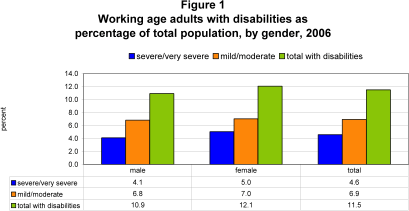
family type
Just over half (51.3 percent or 500,140) of working age Canadians with severe/very severe disabilities are spouses or partners in couple, 41.0 percent (399,920) are other family members and 7.8 percent (75,660) are lone parents. Among those with mild/moderate disabilities, 60.4 percent (890,370) percent are spouses or partners, 33.4 percent (492,430) are other family members and 6.2 percent (92,000) percent are lone parents. See Figure 2.
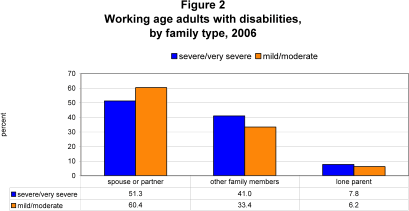
types of disability
The survey looks at 10 types of disability. Among working age individuals with severe/very severe disabilities, pain is the most prevalent problem (it afflicts 871,300 people) followed closely by mobility (864,220) and agility problems (845,670). Next come emotional issues (367,680), learning (349,120), seeing (289,980), memory (273,640), communication (270,280), hearing (240,230) and developmental (95,170). Persons with mild/moderate disabilities experience the same three largest types—pain (958,580), mobility (716,560) and agility (692,060). However, the other types of disability are not, for the most part, not in the same order—hearing (299,600), learning (181,250), seeing (158,540), emotional (137,950), unknown (68,080), communication (66,070), memory (47,290) and developmental (34, 130). See Figure 3.
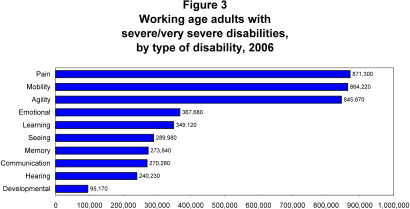
number of disabilities
There is a striking difference in the number of disabilities (from one to six or more) between the two categories. Among persons with severe/very severe disabilities, 48.9 percent or 477,990 have four or five disabilities, followed by 24.6 percent or 240,540 with six or more disabilities, 23.0 percent or 224,450 with three disabilities, 2.8 percent or 27,430 with two disabilities and none with only one disability. Among persons in the mild/moderate disabilities category, 32.0 percent or 474,300 have only one disability, 29.8 percent or 441,830 have three disabilities, 25.1 percent or 372,010 have two disabilities, 12.8 percent or 189,650 have four or five disabilities, and a mere 0.2 percent or 3,010 have six or more disabilities. See Figure 4.
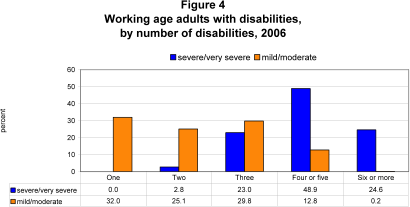
duration of disabilities
The largest group of working age Canadians with severe/very severe disabilities—27.4 percent (387,370)—has experienced disabilities for 20 years or longer. Next come persons who have had disabilities for 10 to 19 years (24.0 percent or 339,140), for 5 to 9 years (20.6 percent or 291,290), 3 to 4 years (12.4 percent or 175,600, 1 to 2 years (11.2 percent or 158,290) and less than one year (4.3 percent or 60,390). The numbers differ for persons with mild/moderate disabilities but the overall pattern is the same: 32.0 percent or 298,490 have had disabilities for 20 or more years, 29.6 percent or 275,780 for 10 to 19 years, 17.0 percent or 158,400 for 5 to 9 years, 8.9 percent or 82,680 for 3 to 4 years, 8.7 percent or 81,600 for 1 to 2 years, and just 3.8 percent or 35,870 for under a year. See Figure 5.
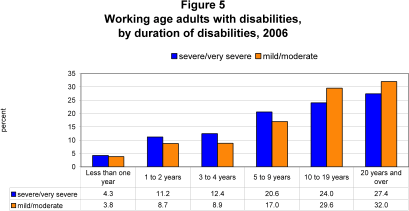
education
Generally speaking, working age Canadians with severe/very severe disabilities have lower levels of education. The largest group are those with less than high school education, who make up 34.1 percent or 333,240 of all those with severe/very severe disabilities. Next come high school grads, at 23.5 percent or 229,810 and 12.9 percent or 126,000 with trades certificates. The numbers increase for college graduates, who comprise 19.3 percent of the total or 188,540. The lowest group—10.1 percent or 99,000—graduated from university. Those with mild/moderate disabilities do better, while those without disabilities generally have higher education than both disability groups. Persons with some form of post-secondary education (i.e., trades, college and university) represent 42.3 percent of those with severe/very severe disabilities, 51.1 percent of those with mild/moderate disabilities and 54.5 percent of working age adults with no disabilities. See Figure 6.
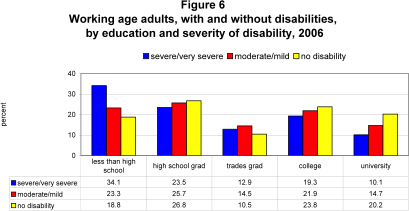
housing
Six in ten (63.9 percent or 624,770) working age adults with severe/very severe disabilities owned their home in 2006, as did 71.9 percent (1,065,020) of those with mild/moderate disabilities and 74.9 percent (14,168,760) of people with no disabilities.
Conversely, 35.8 percent (349,610) of those with serious disabilities rent their accommodation, 27.6 percent (408,110) of people with mild/moderate disabilities and 24.7 percent of those with no disabilities. While most Canadians of working age own their homes, a smaller percentage of those with severe/very severe disabilities own than people with mild/moderate disabilities, and the latter more than those with no disabilities—but the differences are not large. The same pattern holds for renters. The results are illustrated in Figures 7 (owners) and 8 (renters).
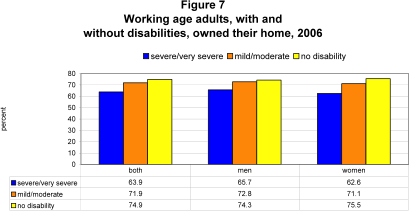
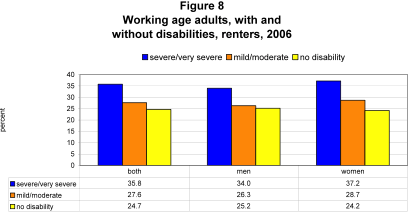
labour force
Working age Canadians with severe/very severe disabilities have a tenuous relationship to the labour force. This generalization is supported by a variety of labour market force indicators.
In 2006, just 36.7 percent (358,250) of persons with severe/very severe disabilities were employed, compared to 60.0 percent (901,730) of workers with mild/moderate disabilities and 75.1 percent (14,198,810) of those without disabilities. The unemployment rate is quite high for working age people with severe/very severe disabilities—12.3 percent or 50,480—as opposed to 7.1 percent (68,860) of those with mild/moderate disabilities and 6.4 percent (964,440) of those without disabilities. The participation rate (i.e., the percentage of Canadians working or actively searching for work) was only 41.9 percent (408,730) for people with severe/very severe disabilities in contrast to 65.5 percent (970,730) of those with mild/moderate disabilities and 80.2 percent (15,163,250) of those with no disabilities. Well over half (58.2 percent or 568,340) of workers with severe/very severe disabilities are not in the labour force versus 34.5 percent (510,260) of those with mild/moderate disabilities and only 19.8 percent (3,751,960) of working age Canadians with no disabilities. See Figure 9.
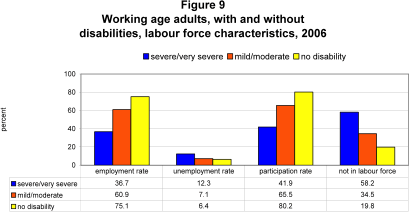
One in ten workers (10.5 percent) with severe/very severe disabilities worked less than 30 hours a week and 18.3 percent more than 30 hours a week, but 71.1 percent did not work. Most of those with mild/moderate disabilities worked—13.6 percent less than 30 hours a week and 42.8 percent more than 30 hours a week—leaving 43.6 percent not in work. More than half (57.8 percent) of those without disabilities worked more 30 hours a week, 27.9 percent did not work and 14.3 percent worked less than 30 hours per week. See Figure 10.
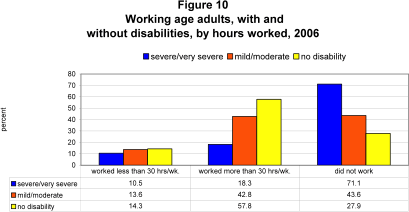
Only 31.1 percent of working age adults with severe/very severe disabilities were union members in 2006 and 68.9 percent were not. The results are similar for persons with mild/moderate disabilities 36.1 percent belonged to a union and 63.9 percent did not. Figure 11 shows the figures.
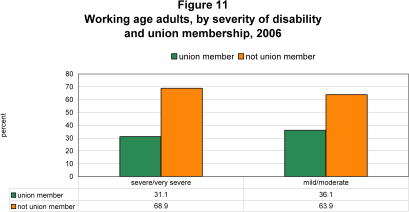
Half (50.1 percent) of working age people with severe/very severe disabilities prefer part-time work, but a significant 27.7 percent want full-time work and 22.2 percent either full-time or part-time employment. A lower percentage (41.3 percent) of those in the mild/moderate disabilities category prefer full-time work, 43.5 percent want to work full-time and 15.1 percent either full-time or part-time. See Figure 12.
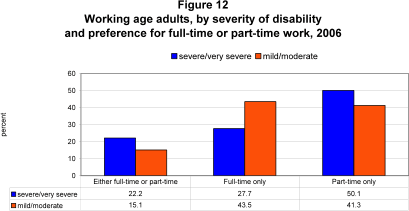
The largest group of workers with severe/very severe disabilities—34.2 percent—are employed in small workplaces of less than 20 employees, followed by 27.3 percent in workplaces of 100 to 500, 27.2 percent for employers with 20-99 workers and 11.2 percent in large workplaces of more than 500. The results for workers with mild/ moderate disabilities are 35.5 percent for workplaces with fewer than 20 employees, 28.7 percent for workplaces with 20 to 99 employees, 20.7 percent for the 100 to 500 size, and 15.1 percent for those over 500. The results are shown in Figure 13.
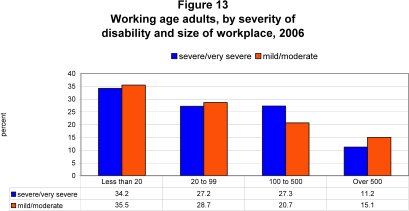
The top three industries employing workers with severe/very severe disabilities are manufacturing (59,150), retail trade (55,380) and health and social services (48,980). Figure 14 gives all the results.
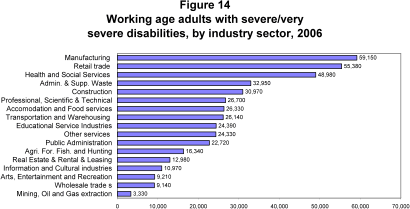
Among working age adults with severe/very severe disabilities who experienced unemployment in 2006, 71.7 percent had one bout, 10.8 percent had two periods and 17.4 percent had three or more periods. The results for those with mild or moderate disabilities are 68.8 percent for one bout, 14.5 percent for two and 16.7 percent for three or more episodes of unemployment. See Figure 15.
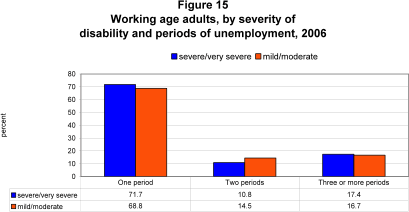
Among working age adults with severe/very severe disabilities who experienced unemployment in 2006, 43.5 percent were out of work for six months or more, 35.6 percent for less than three months and 20.0 percent for three to five months. Among the unemployed with mild or moderate disabilities, 43.4 percent were jobless for less than three months, 28.6 percent for six months or more, and 28.0 percent for three to five months. Figure 16 shows the findings.
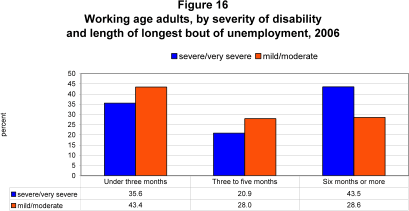
income from employment
Canadians with disabilities have lower incomes than those without. More than half (54.4 percent) of working age adults with severe/very severe disabilities had employment earnings less than $20,000 in 2006 as opposed to 37.0 percent of those with mild/moderate disabilities and 35.7 percent of workers without disabilities.
Workers with disabilities have lower earnings than those without disabilities even when they have the same education. Workers with severe/very severe disabilities and less than high school education had average employment income of $22,295 compared to $22,091 for those with mild/moderate disabilities and $23,310 for workers with no disabilities. Workers with severe/very severe disabilities and a high school diploma averaged $21,336 as opposed to $27,020 for those with mild/moderate disabilities and $30,185 for those without disabilities. Workers with severe/very severe disabilities and a trades certificate averaged $25,835 versus $34,491 for those with mild/moderate disabilities and $35,531 for those without disabilities. And workers with college or university degrees and severe/very severe disabilities averaged only $24,997 in contrast to $42,161 for those with mild/moderate disabilities and $49,083 for those without disabilities. See Figure 17.
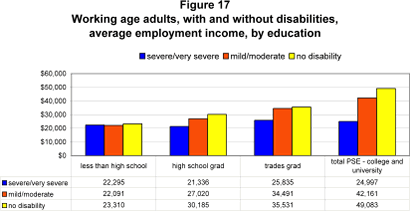
Gender differences are significant when it comes to earnings for workers with and without disabilities. The average employment income for women with severe/very severe disabilities was only $17,459 in 2006 compared to $31,172 for men in the same category. The pattern is the same for workers with mild/moderate disabilities—$27,988 for women and $39,755 for men—and for workers without disabilities—$ 30,517 for women and $46,625 for men. See Figure 18.
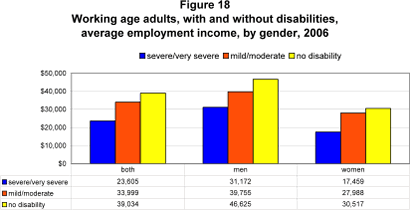
total income
The story is the same when we look at total income from all sources (i.e., employment, government programs, savings and investments). Working age Canadians with disabilities have lower average incomes than those who have no disabilities, and women have lower incomes than men in each disability and no-disability category. Among people with severe/very severe disabilities, women had average income of $16,481 in 2006 compared to $24,073 for men. Among those with mild/moderate severe disabilities, women averaged $23,844 while men had $35,983. Women without disabilities had average income of $27,670 versus $44,049 for men without disabilities. See Figure 19.
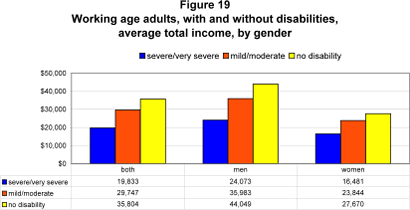
low income
Working age Canadians with disabilities run a higher risk of low income than those without disabilities. In 2006, 27.1 percent of people with severe/very severe disabilities lived on low incomes compared to 15.9 percent of persons with mild/ moderate disabilities and 10.7 percent for those with no disabilities. Again, the gender differences are striking. Among those with severe/very severe disabilities, 27.5 percent of women were below the poverty line in 2006 versus 16.4 percent of men. Among those with mild/moderate disabilities, 16.7 percent of women and 15.9 percent of men had low incomes. Among working age adults without disabilities, 11.5 percent of women and 10.0 percent of men were below the poverty line. See Figure 20.
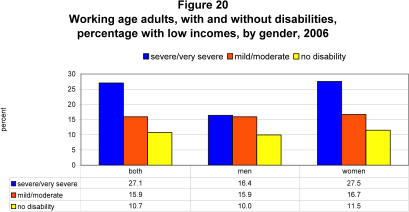
Digging deeper, we find that the low income rate is directly related to the four degrees of disability. The poverty rate is 31.2 percent for working age Canadians with very severe disabilities, 25.0 percent for those with severe disabilities, 18.0 percent for those with moderate disabilities and 14.4 percent for those with mild disabilities.
income from government programs
The survey's findings on sources of income from public programs show that significant numbers—though still a minority—of Canadians with severe/very severe disabilities receive benefits from three programs—the Canada/Quebec Pension Plan, the Canada/Quebec Pension Plan Disability program and welfare. A small proportion reported benefits from Employment Insurance, Workers' Compensation and the veterans' disability pension.
In 2006, 25.9 percent (252,610) of working age adults with severe disabilities and 24.2 percent (224,510) of those with mild/moderate disabilities received benefits from the Canada or Quebec Pension Plan—but less than the 27.2 percent (886,960) of those without disabilities; far fewer women than men received benefits. See Figure 21.
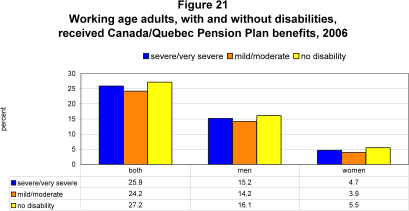
In 2006, 24.5 percent (239,620) of persons with severe/very severe disabilities got income from the Canada/Quebec Pension Plan Disability benefit in 2006 compared to just 8.2 percent (120,840) of those with mild/moderate disabilities. See Figure 22.
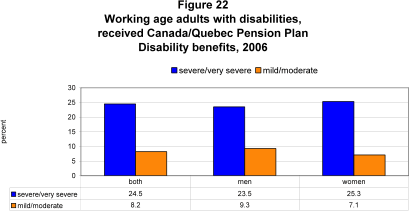
Social assistance (better known as welfare) delivered by the provincial, territorial and municipal governments is another important social program for many Canadians with disabilities. In 2006, 21.8 percent (212,640) of persons with severe/very severe disabilities received income from welfare and 9.9 percent (146,240) of those with mild/moderate disabilities. Breaking down these results further, 25.4 percent of people with very severe disabilities reported welfare benefits, 19.9 percent of those with severe disabilities, 12.4 percent with moderate disabilities and 8.0 percent of those with mild disabilities. Figure 23 illustrates the results.
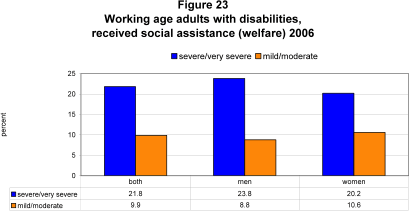
The Canada Child Tax Benefit delivered income to 13.5 percent (131,980) of working age adults with severe/very severe disabilities, 12.5 percent (185,660) of those with mild/moderate disabilities and 16.9 percent (3,200,010) of those with no disabilities. Women accounted for the large part of benefits because the Canada Child Tax Benefit is claimed by the lower income spouse in families with children, and women have lower incomes overall than men. See Figure 24.
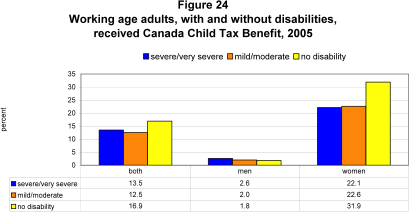
Only 9.0 percent (87,920) of those with severe/very severe disabilities had benefits from provincial Workers' Compensation, though the result for those with mild/moderate disabilities is even lower—5.6 percent or 83,350. See Figure 25.
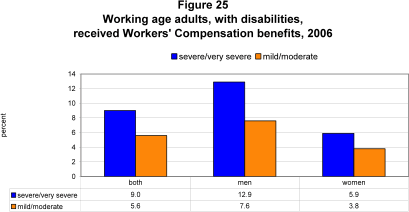
In 2006, a mere 7.2 percent (70,820) of working age adults received federal Employment Insurance benefits as opposed to 9.1 percent (134,040) of people with mild/moderate disabilities and 10.2 percent (1,923,650) of persons with no disabilities. See Figure 26.
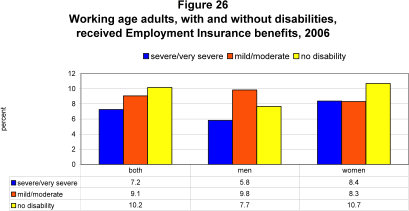
The federal government's veterans' disability pension served only 0.9 percent or 8,540 of persons with severe/very severe disabilities and 0.7 percent (10,550) of those with mild/moderate disabilities. The sample size is too small to permit estimates for female recipients.
income from private sources
The programs discussed above are provided by government. Canadians with disabilities also receive income from private sources.
A sizeable 23.2 percent (227,090) of working age adults with severe/very severe disabilities had some investment income in 2006, a larger 29.5 percent (437,430) of those with mild/moderate disabilities and 27.6 percent (5,212,300) of those without disabilities. See Figure 27.
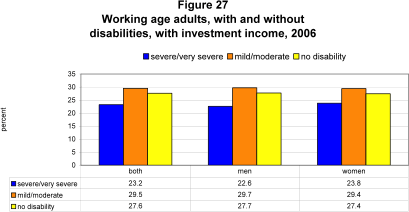
One in ten (10.3 percent or 100,310) adults with serious disabilities got benefits from private disability insurance in 2006 and 5.1 percent or 75,320 of those with mild or moderate disabilities. See Figure 28.
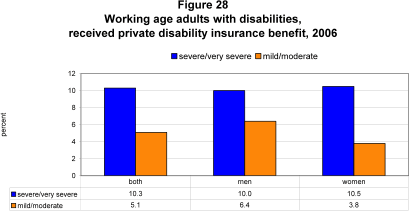
Among working age adults with severe/very severe disabilities, 2.6 percent (25,030) received benefits from motor vehicle accident insurance and 1.5 percent (22,130) of those with mild/moderate disabilities. Figure 29 illustrates the results.
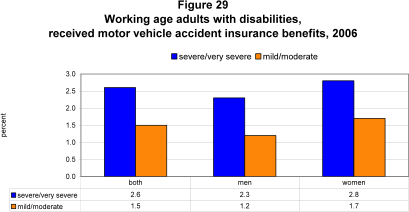
Welfare Income Trends
The series of graphs below illustrate trends in the value of welfare incomes for single people with disabilities in each province and territory (except Yukon, because the estimates are contentious). All amounts are shown in constant 2008 dollars to show real (inflation-adjusted) trends.
Figure 30 shows welfare incomes for single recipients with disabilities in Newfoundland. Welfare incomes peaked at $11,792 in 1997 and fell steadily to $10,370 in 2005, after which they gained some ground to reach $11,128 in 2007 though they slipped to $10,977 in 2008. Between 1989 and 2008, they fell by a modest $576 or 5 percent, so over the long term Newfoundland's welfare benefits for single recipients have not changed much.
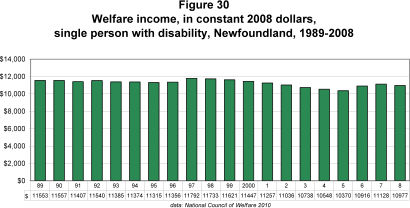
PEI, shown in Figure 31, has experienced a substantial decline in its welfare incomes, from a high of $12,496 in 1992 to a low of $10,370 in 2005—a loss of $3,630 or 31.0 percent. They fell by $3,572 or 30.6 percent between 1989 and 2005.
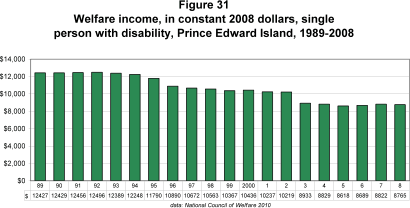
In Nova Scotia, illustrated in Figure 32, welfare incomes for single recipients with disabilities declined from a high of $11,986 in 1991 to a low of $8,618 in 2008. Welfare incomes fell by a substantial $2,770 or 23.3 percent between 1989 and 2008.
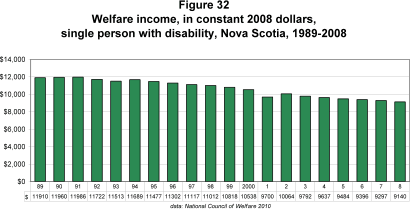
The trend in New Brunswick (Figure 33) also illustrates a long-term decline, from a peak high of $11,343 in 1989 to a low point of $7,473 in 1999, after which it recovered a bit to $8,554 in 2000 and has not changed much since. The long-term loss is $2,847 or 25.1 percent. Note, though, that welfare incomes for recipients with disabilities in New Brunswick have been pretty much the same since 1994, the result of de facto indexation through regular adjustments in benefits.
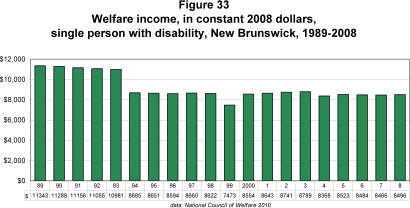
Figure 34 shows that Quebec is similar to New Brunswick in that its welfare incomes have been relatively the same level since 1991, thanks to formal indexation of benefits. However, unlike New Brunswick and most other jurisdictions, Quebec's welfare incomes for single persons with disabilities have increased somewhat over the long term, from $9,743 in 1989 to $10,630 in 2008—an increase of $887 or 9.1 percent.
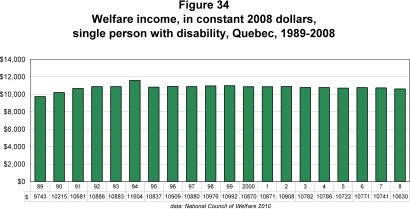
Ontario's welfare incomes for single persons with disabilities, illustrated in Figure 35, climbed from $13,948 in 1989 to a peak of $15,716 in 1992 and then declined steadily and substantially to a low of $12,667 in 2007—a long-term decline of $1,001 or 7.2 percent between 1989 and 2008. Erosion as a result of lack of indexation and a lengthy freeze in welfare rates account for the decline. Welfare benefits were increased by three percent in March 2005, but welfare incomes were still lower in 2005 than 2004 because of a lump sum special payment in the fall of 2004. Ontario has been raising its welfare rates a bit over the past few years.
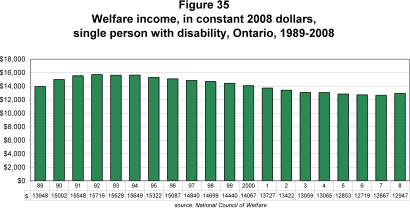
Welfare incomes for single persons with disabilities in Manitoba rose in 1992 but thereafter declined. Between 1989 and 2008, they fell by $756 or 7.5 percent. However welfare incomes have levelled off since 2005. Figure 36 shows the trend.
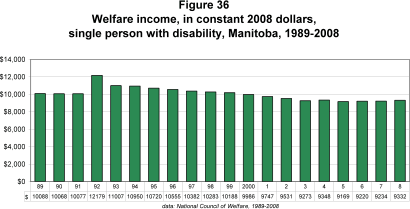
Welfare incomes for single recipients with disabilities in Saskatchewan show a pretty steady decline to 2005, as illustrated in Figure 37. They fell from $12,185 in 1989—the peak year—to $8,893 in 2005, but then rose in 2006, 2007 and 2008 to reach $10,477 in 2008. Between 1989 and 2008, the province saw a $1,708 or 14.0 percent loss in the value of its welfare incomes for single recipients with disabilities.
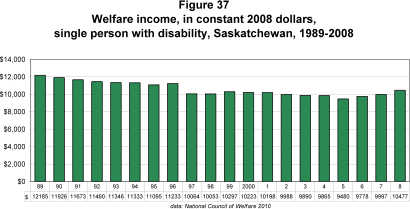
The trend in Alberta shows a relatively flat situation overall, with some small ups and downs over the years as indicated in Figure 38. Welfare incomes for single persons with disabilities fell by $392 or 4.3 percent between 1989 and 2008.
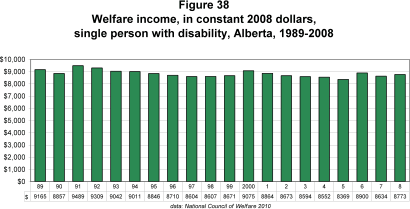
However, Alberta had created a new program for persons with disabilities, Alberta Income for the Severely Handicapped (AISH). As noted earlier, AISH is targeted to those with severe and prolonged disabilities, and is more generous than the benefit for persons with disabilities who do not qualify for AISH and receive instead the lower rate in the traditional welfare system that is tracked in the previous paragraph and Figure 38. Estimates for AISH income are available for only three years. From $13,120 in 2007 they fell slightly to $13,055 in 2007 but rose to $13,377.
Single welfare recipients with disabilities in British Columbia have seen a gradual up-down-up pattern in their incomes over the years, as shown in Figure 39, though they have more or less levelled off since 2005. Incomes fell slightly by $123 or 1.1 percent between 1989 and 2008.
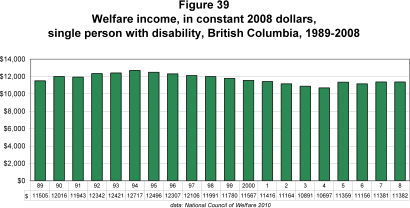
The trend in welfare incomes for single recipients in Yukon, illustrated in Figure 40, resembles a two-step plateau with a spike in 1997 and 1998, and then a decline to a higher plateau than between 1989 and 1996. The long-term increase amounts to a hefty $4,795 or 39.3 percent between 1989 ($12,186) and 2008 ($16,981).
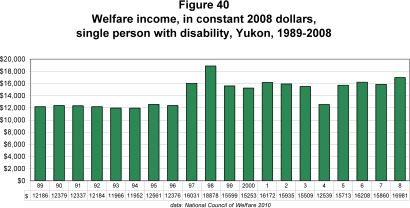
Figure 41 indicates a three-plateau pattern in the Northwest Territories, with welfare incomes for single recipients with disabilities around $17,000 between 1993 and 1996, dropping to around $12,000-$13,000 from 1997 through 2001, then rising again to around $17,000-$18,000 from 2002 to 2006 with an increase to $19,378 in 2007 and $20,910 in 2008. The long-term increase between 1993 ($17,468) and 2008 ($20,910) is $3,442 or 19.7 percent.
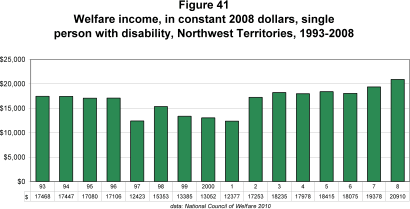
Endnotes
- [1] The reforms presented in this paper are one component of a larger comprehensive ‘re-imagination’ of Canada’s whole income security system for working age adults, which we have described in Towards a New Architecture for Canada's Adult Benefits [Battle et al. 2006]. The Basic Income program is the ‘Tier 3’ of the proposed new architecture; however the restructuring presented here also stands on its own.
- [2] Severity of disability is determined as follows: “An index measuring the severity of disability was constructed based on the answers to the survey questions. Points were given according to the intensity and the frequency of the activity limitations reported by the respondent. A single score was computed for each type of disability. Each score was then standardized in order to have a value between 0 and 1. The final score is the average of the scores for each type of disability…The scale for adults and for children aged 5 to 14 was divided into four groups (that is, mild, moderate, severe and very severe) [Statistics Canada 2007].
- [3] The data presented here and in the Appendix were obtained through special runs of Statistics Canada’s Participation and Activity Limitation Survey. We are grateful to Statistics Canada for providing us with this data, though Caledon alone is responsible for its use and interpretation.
- [4] The national average excludes in the denominator Nunavut because disability caseload data is not available.
- [5] Coined by the Caledon Institute, the term ‘welfare wall’ refers to the fact that recipients who manage to leave welfare for work face a number of barriers or, in the language of economists, disincentives to work.
- [6] All welfare figures in this section are from National Council of Welfare 2010. We have excluded Nunavut because its officials dispute the National Council of Welfare’s figures.
- [7] Nunavut is excluded, as explained in endnote 4 above. We did not include Alberta’s AISH program (for recipients with a severe and permanent disability that substantially limits their ability to earn a living) because there are figures for three years only (2006, 2007 and 2008).
- [8] Based on estimates from data on Canada Revenue Agency ‘Final Basic Table 10: Selected items by total income class, All Canada’ for 2007 tax year. http://www.cra-arc.gc.ca/gncy/stts/gb07/pst/fnl/html/tbl10-eng.html

End Exclusion supporters rally in support of an accessible and inclusive Canada.
